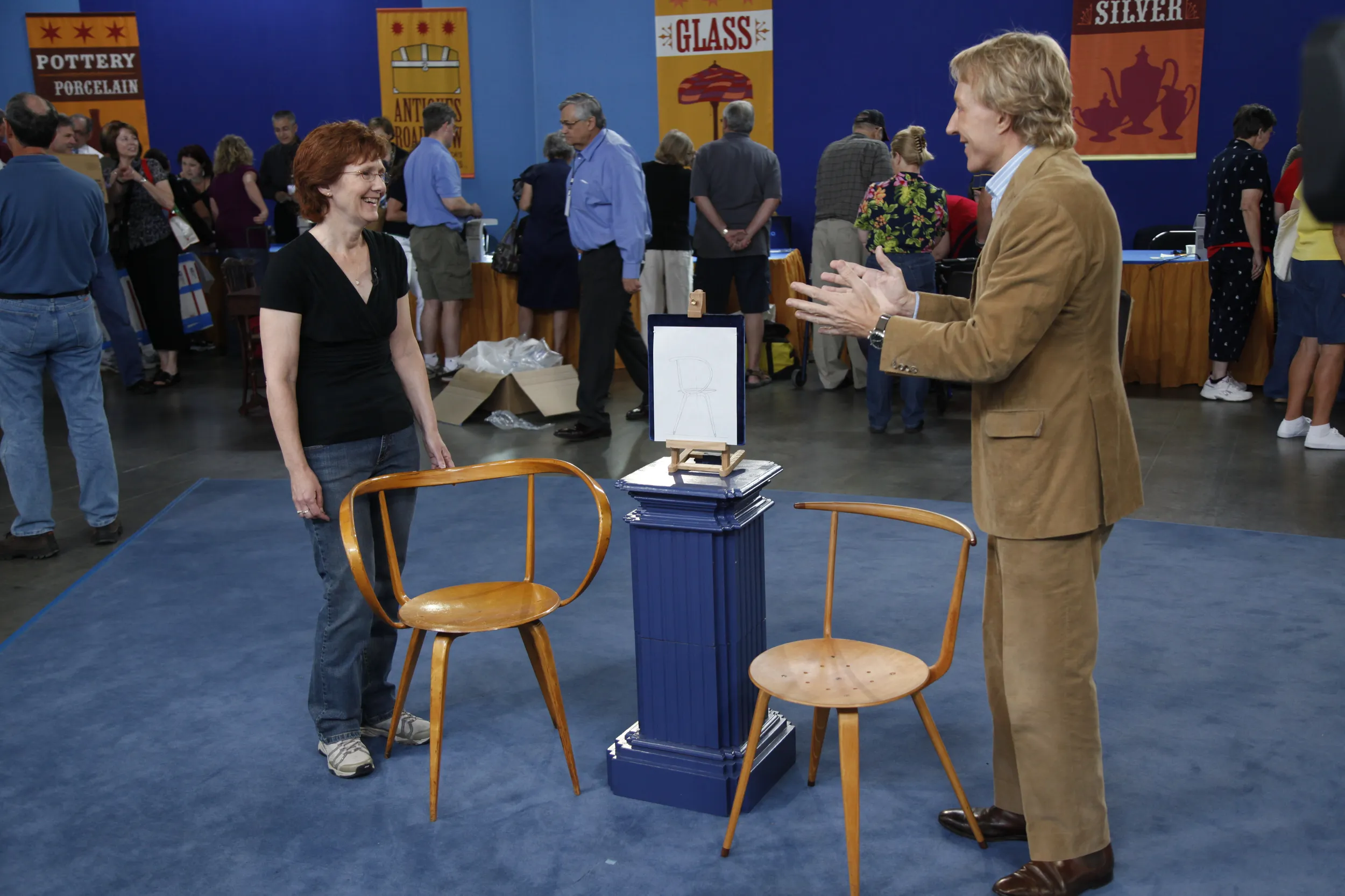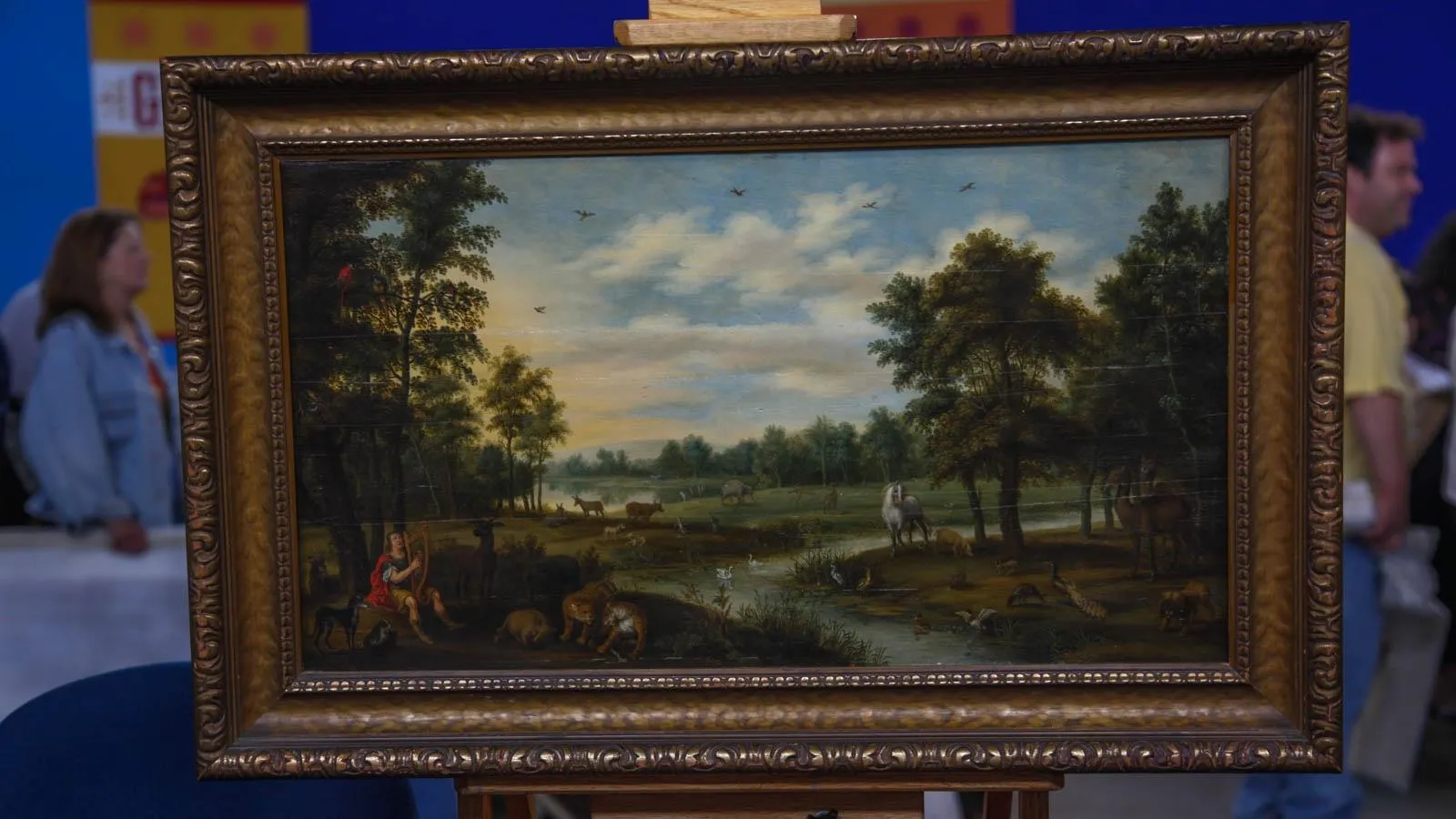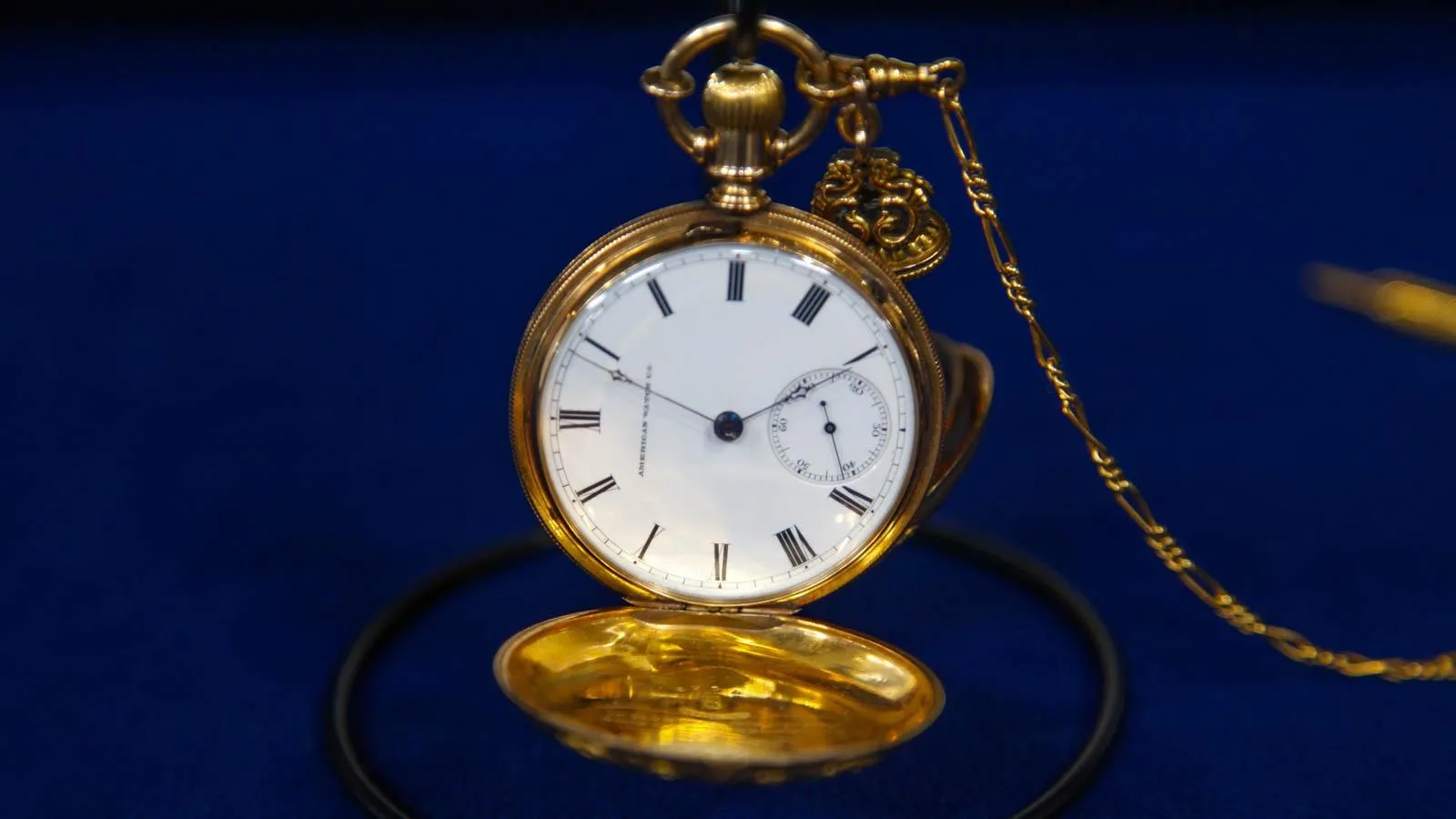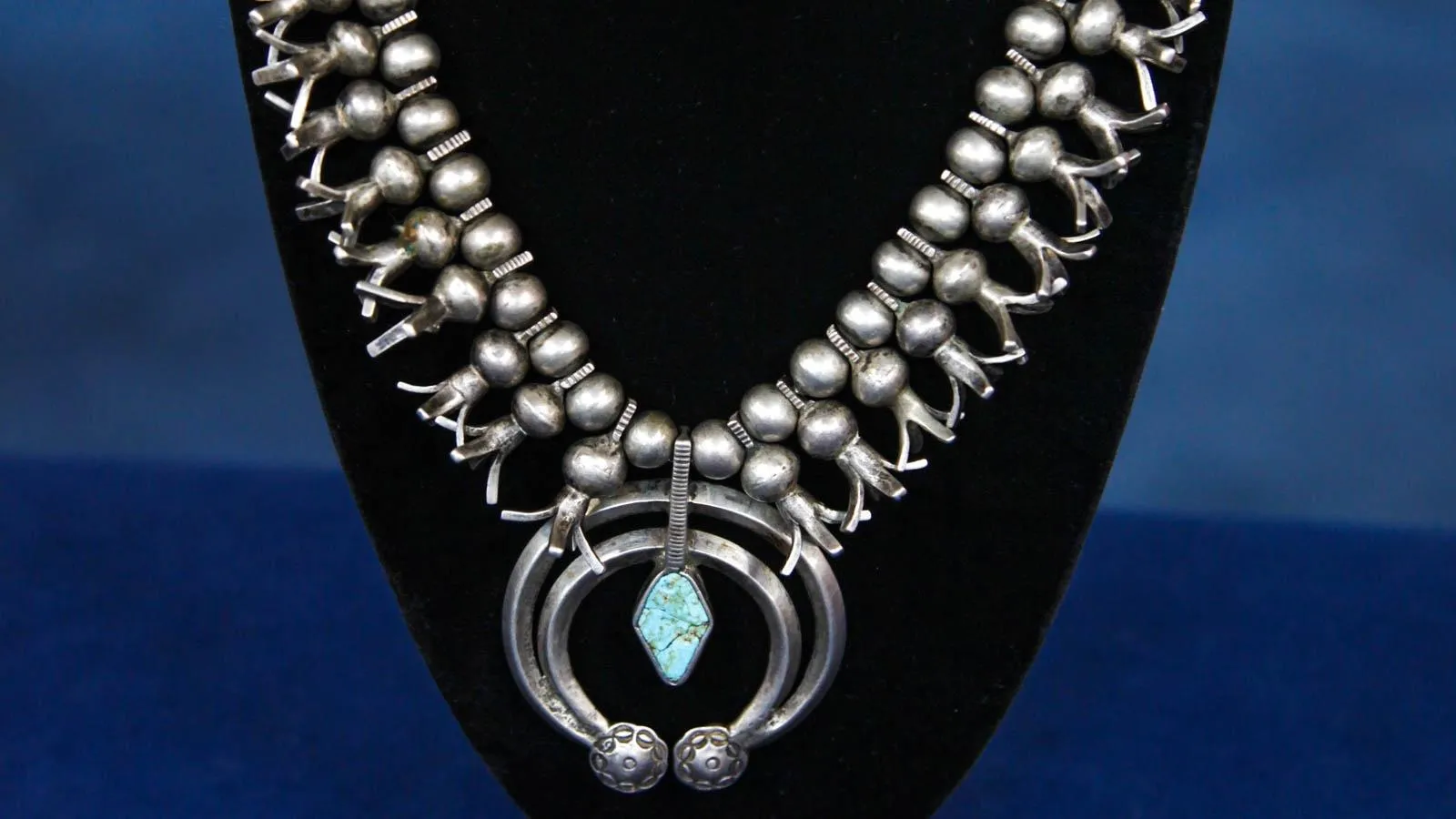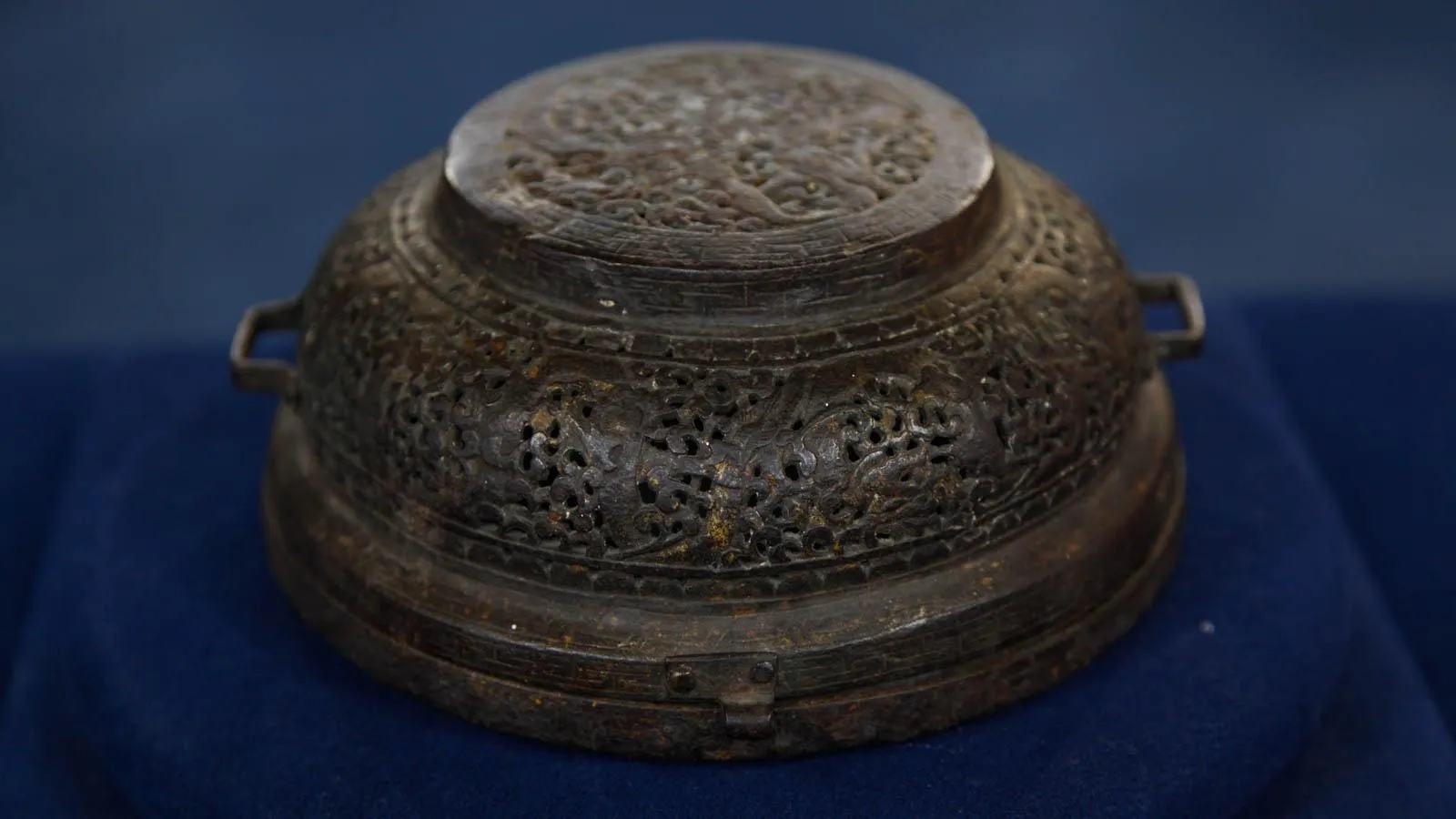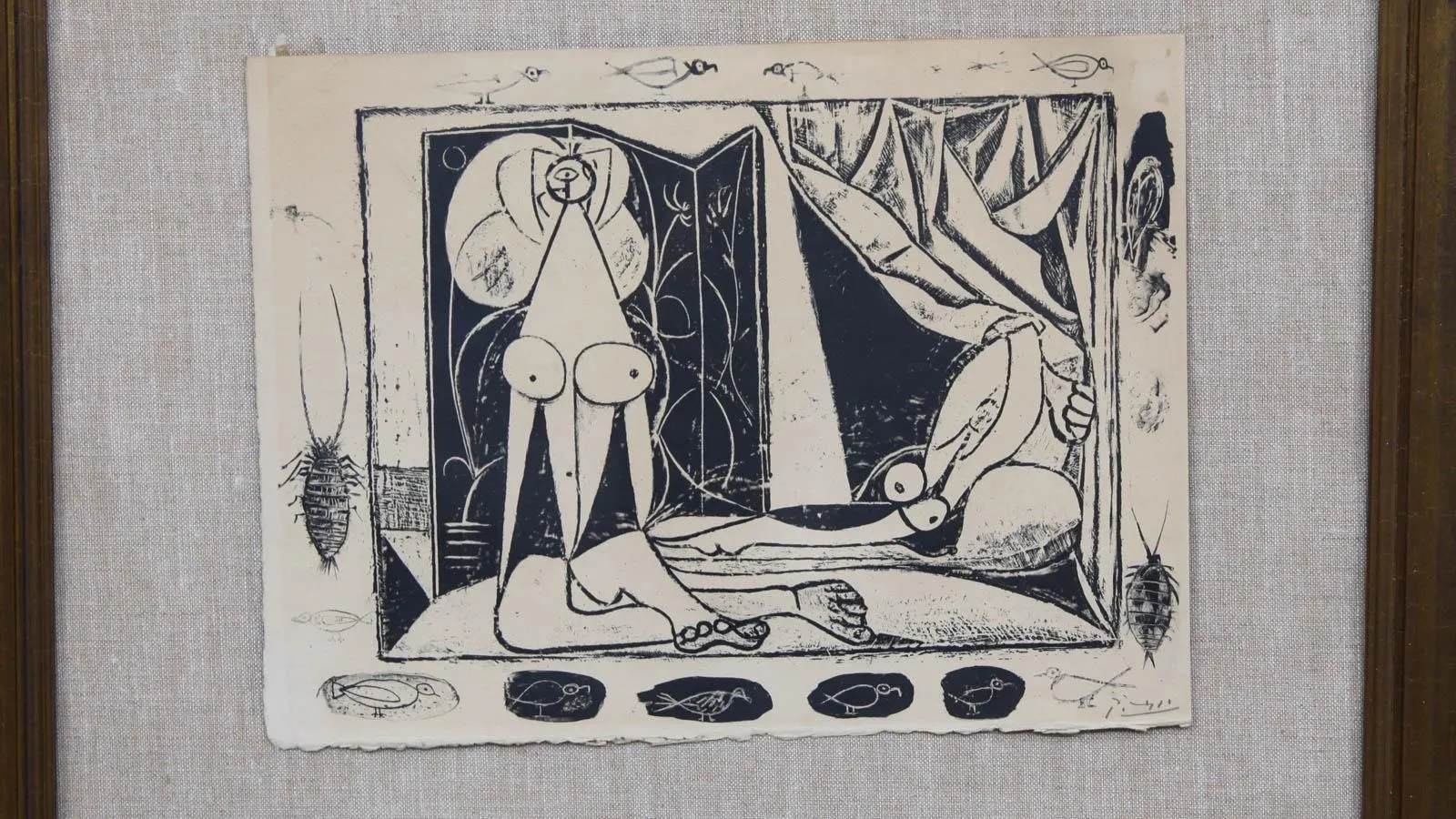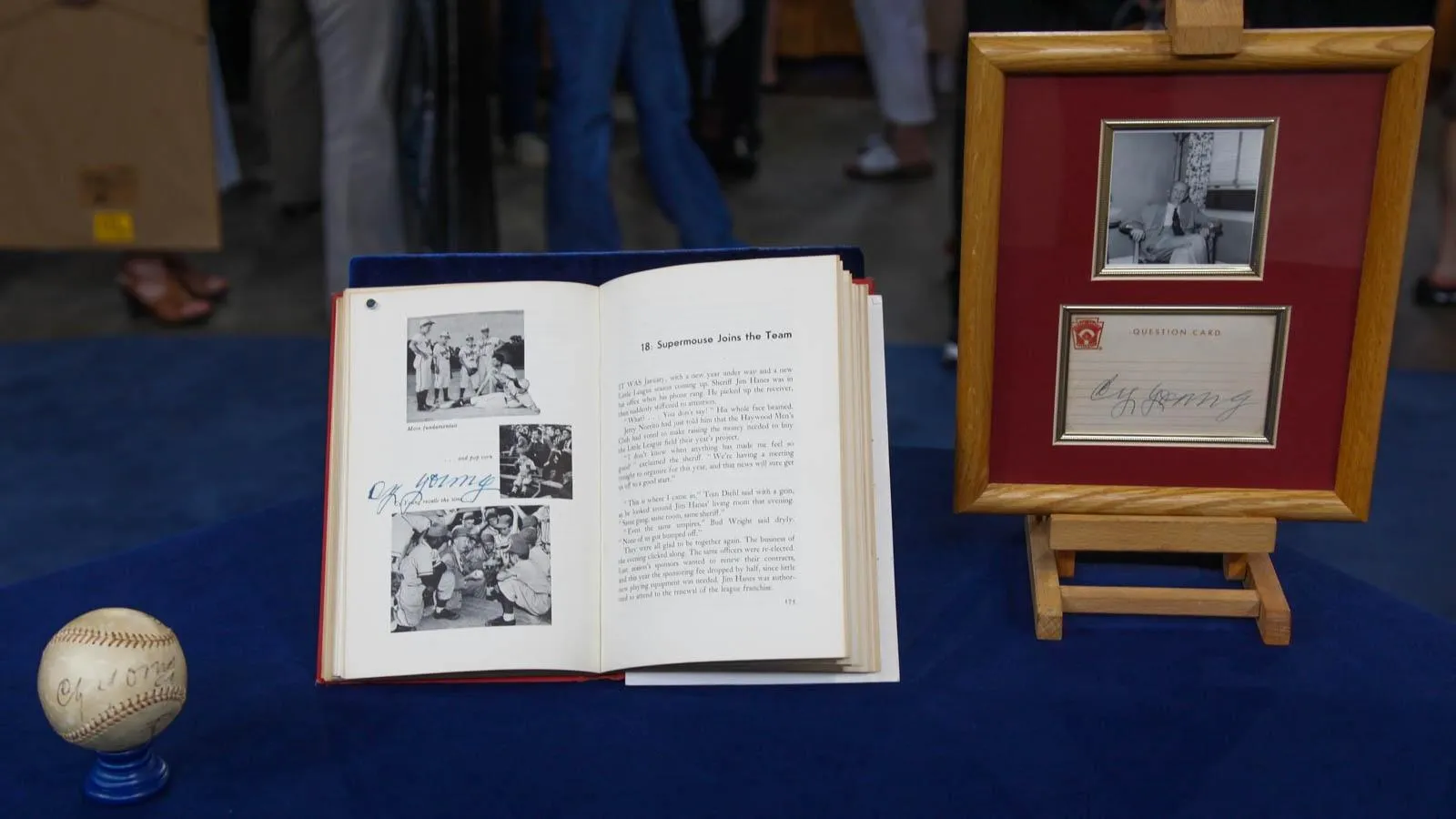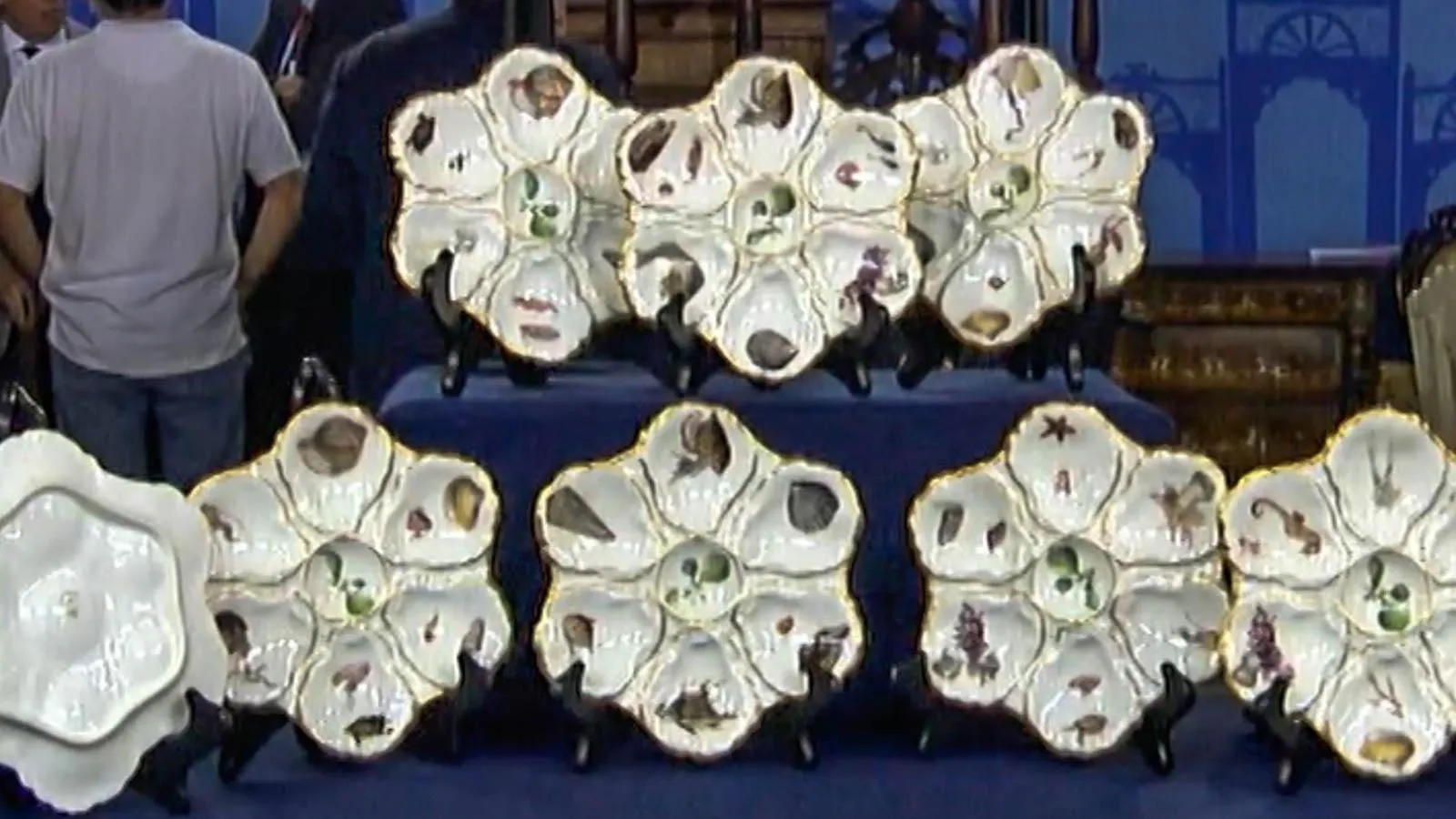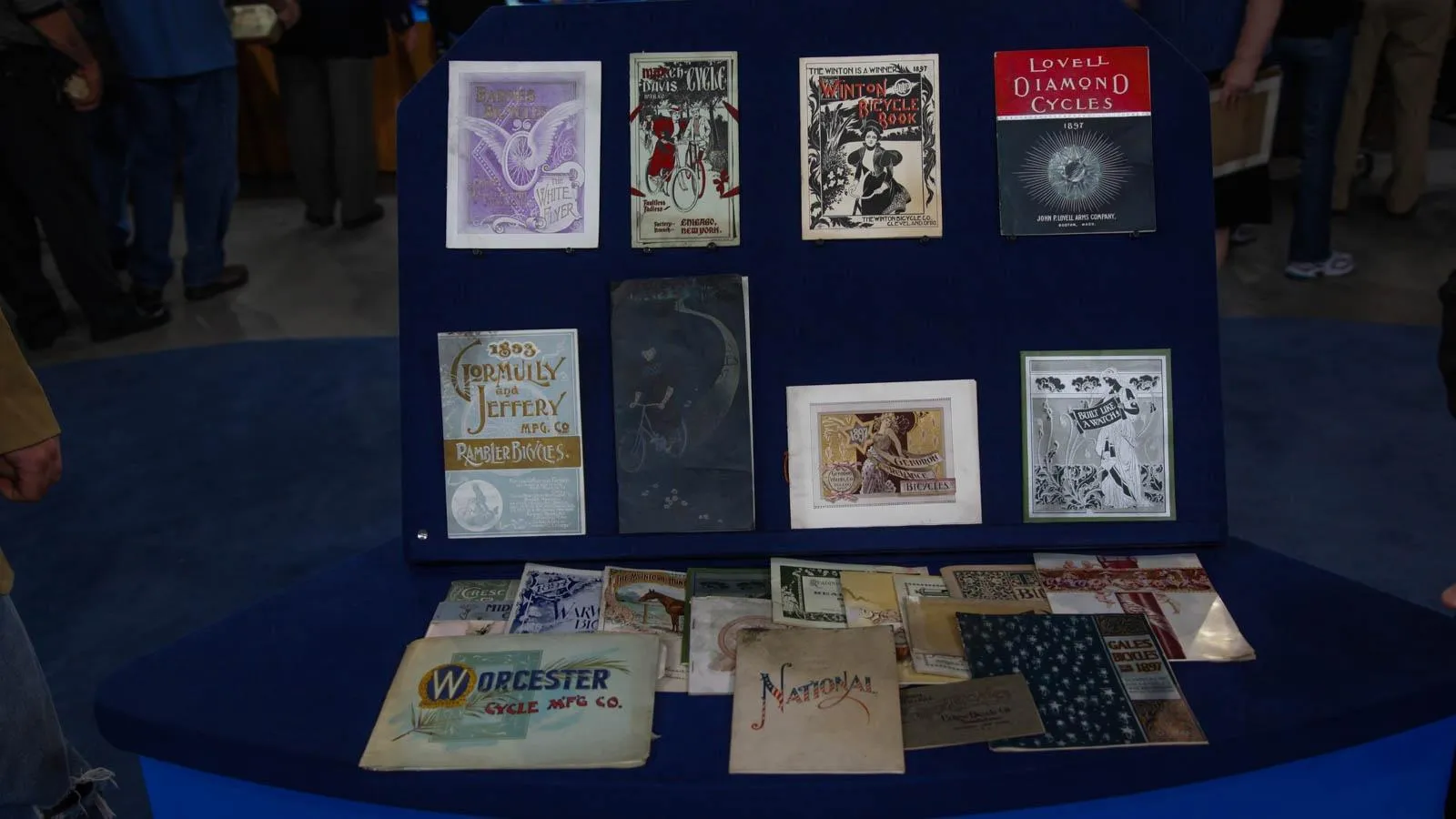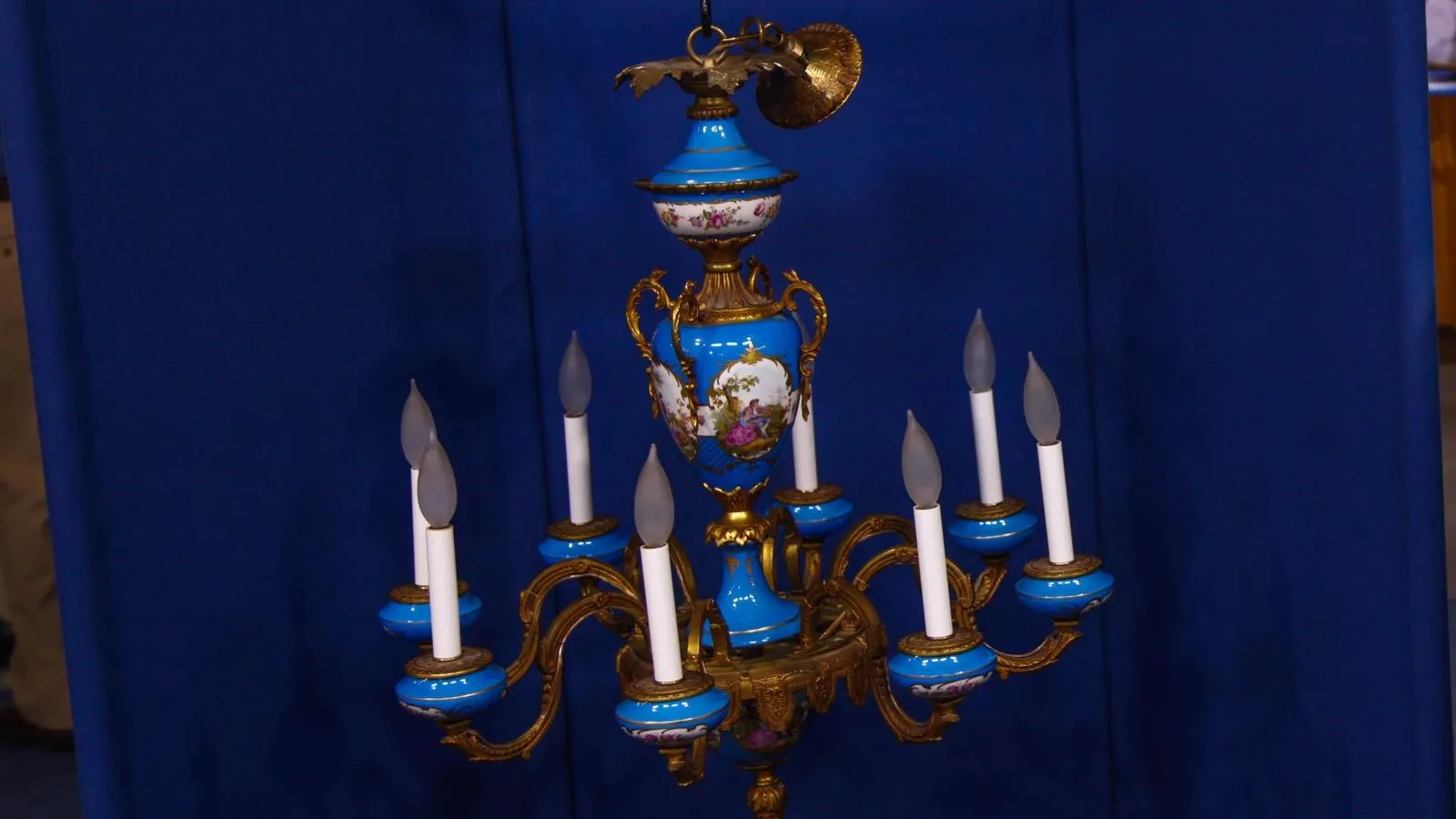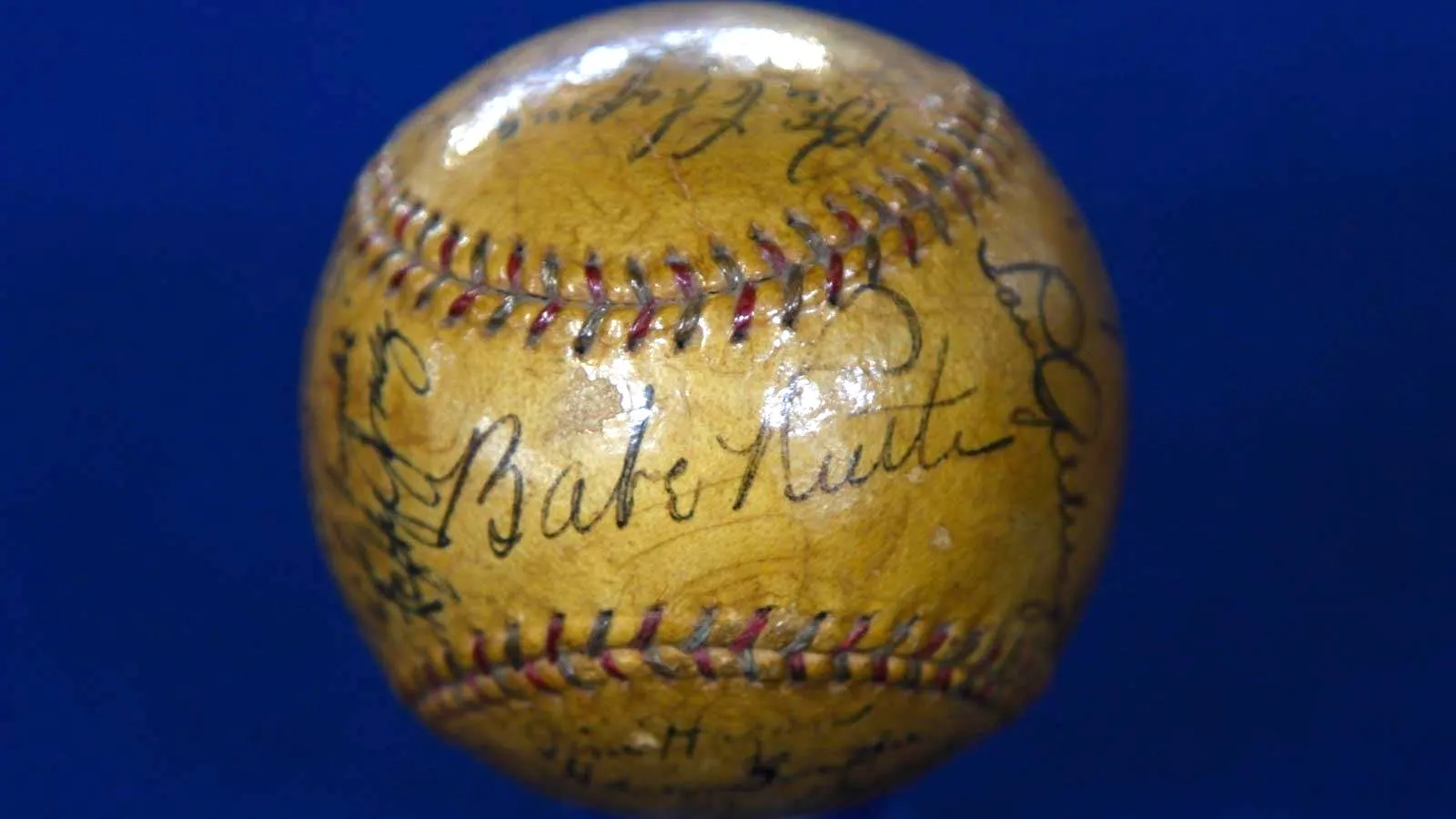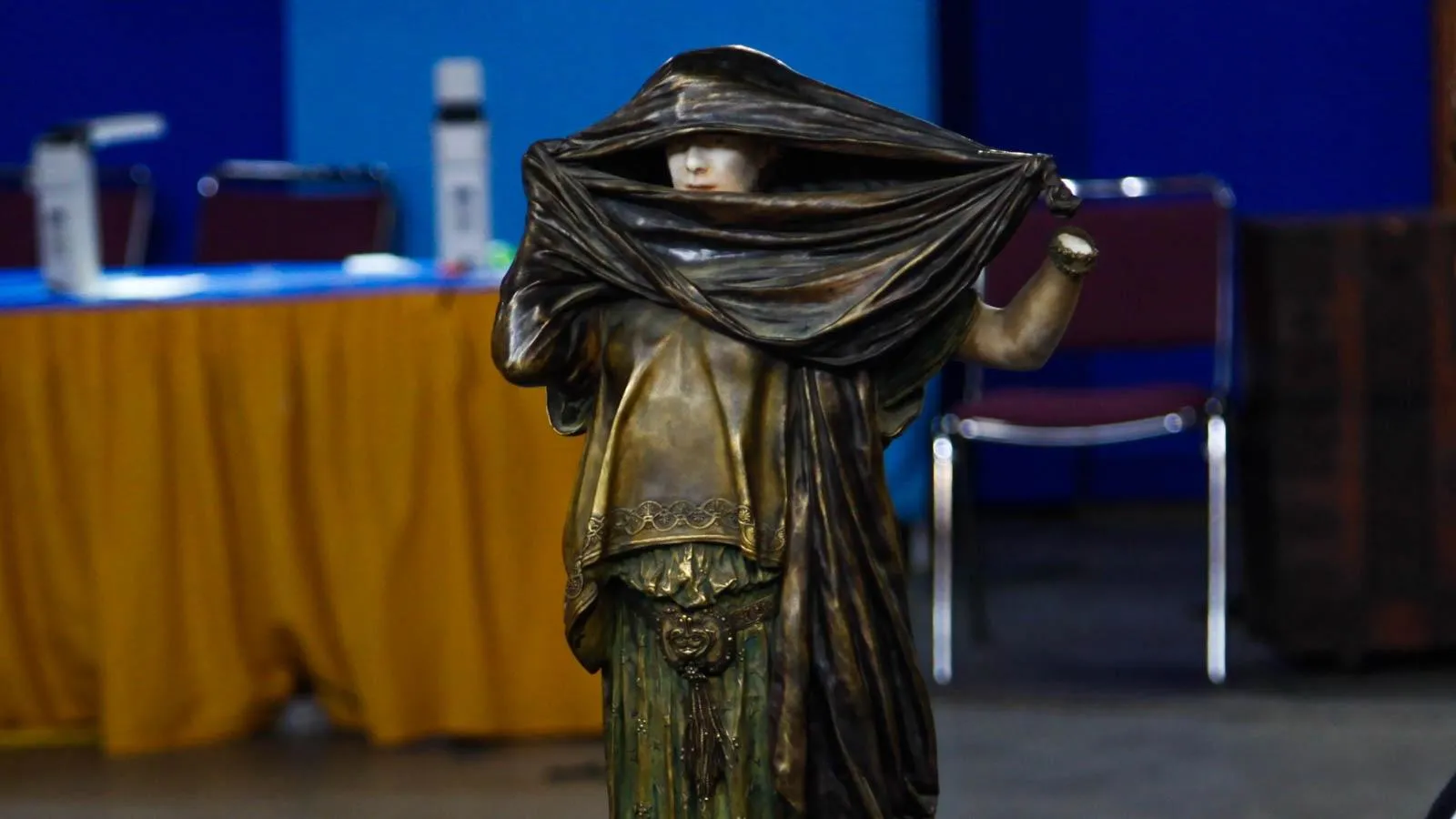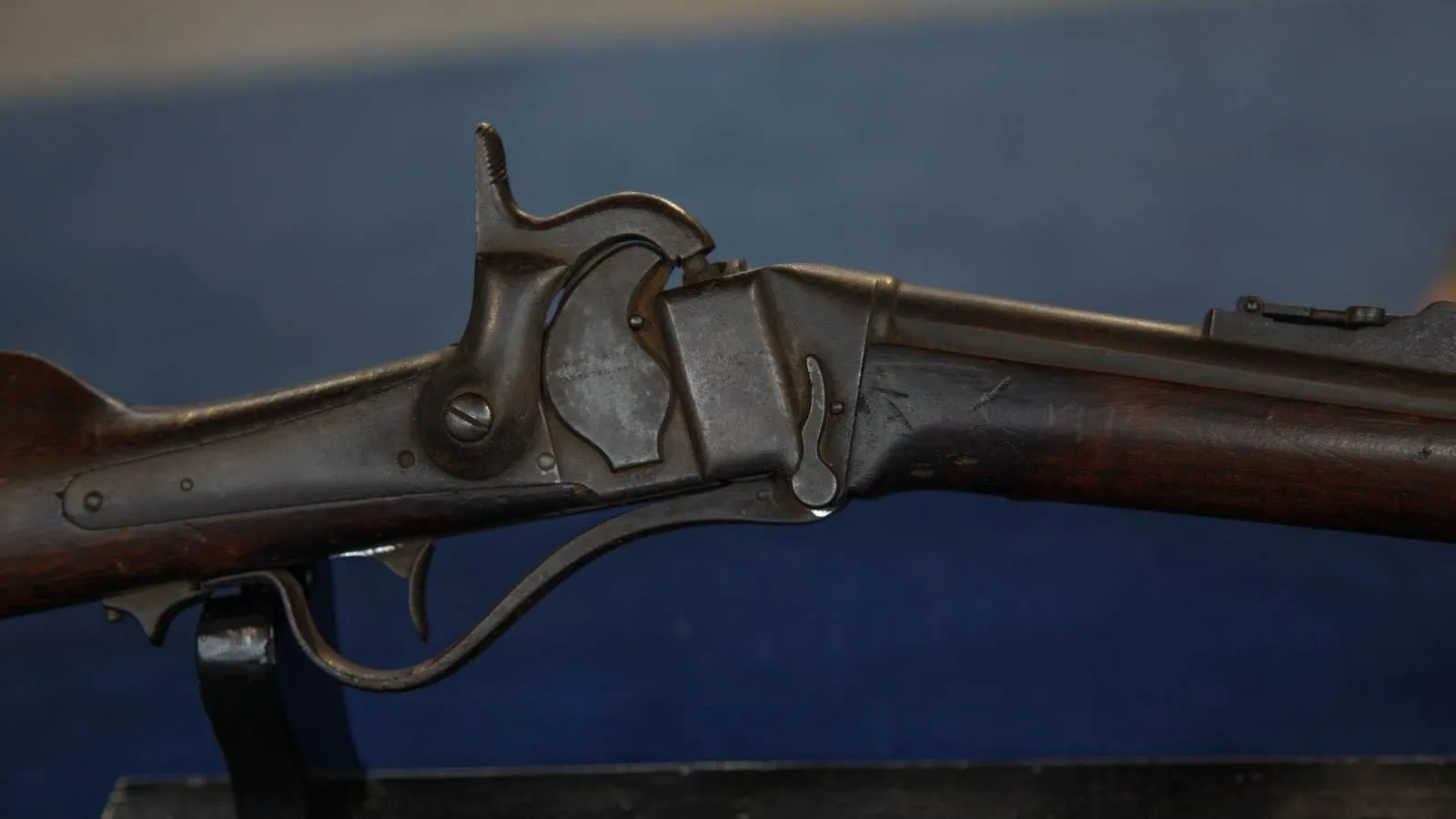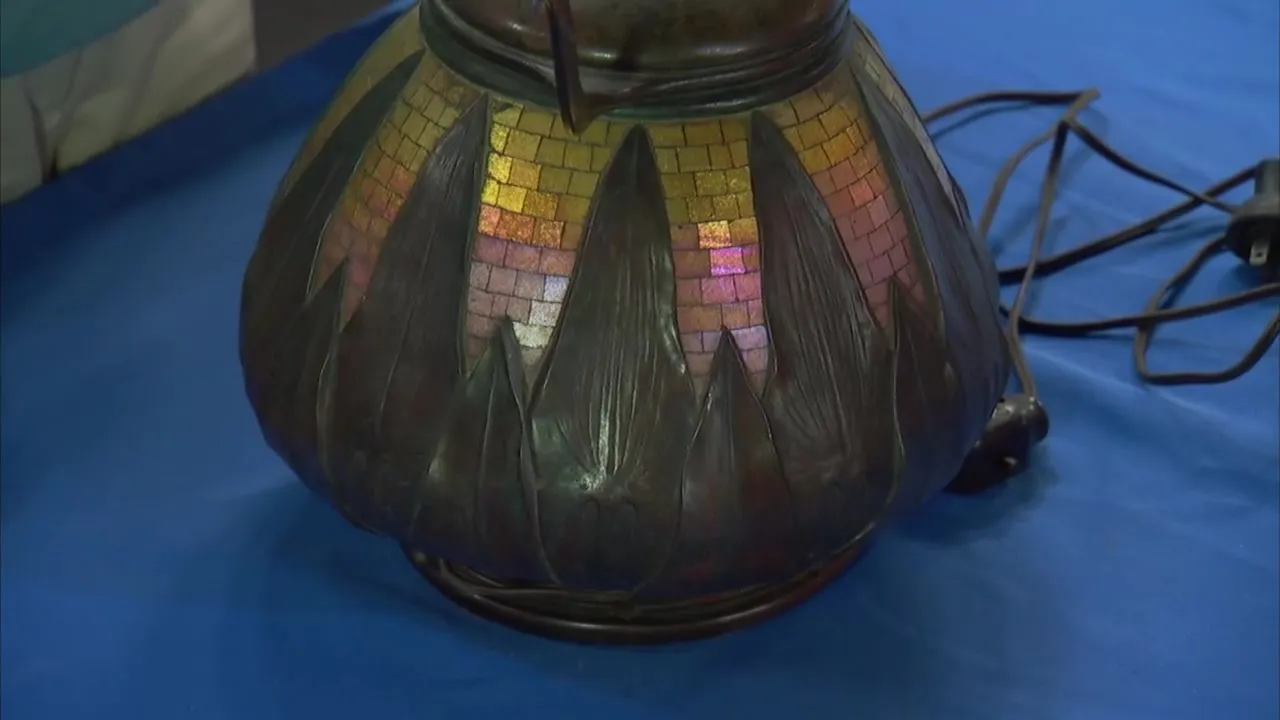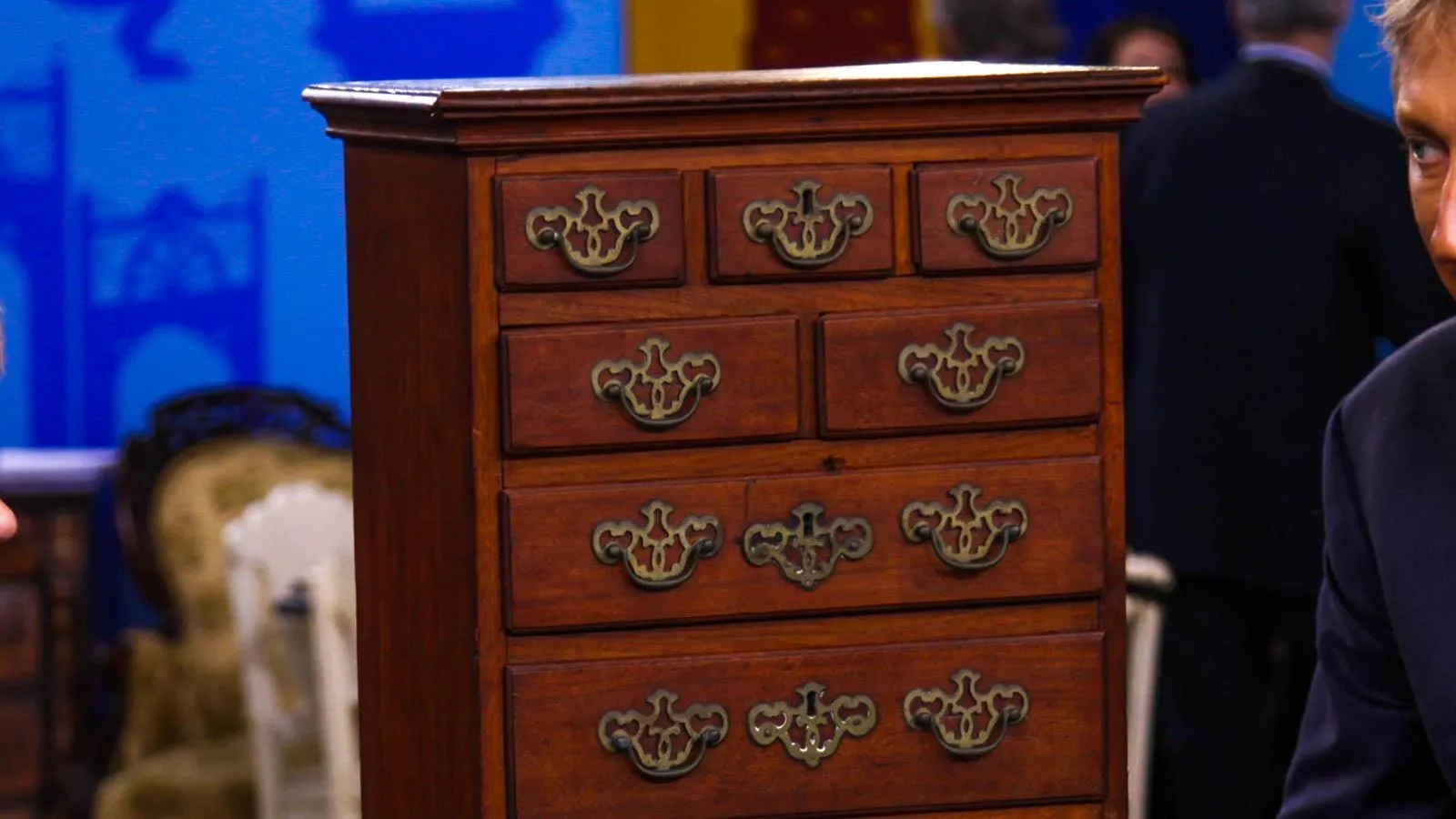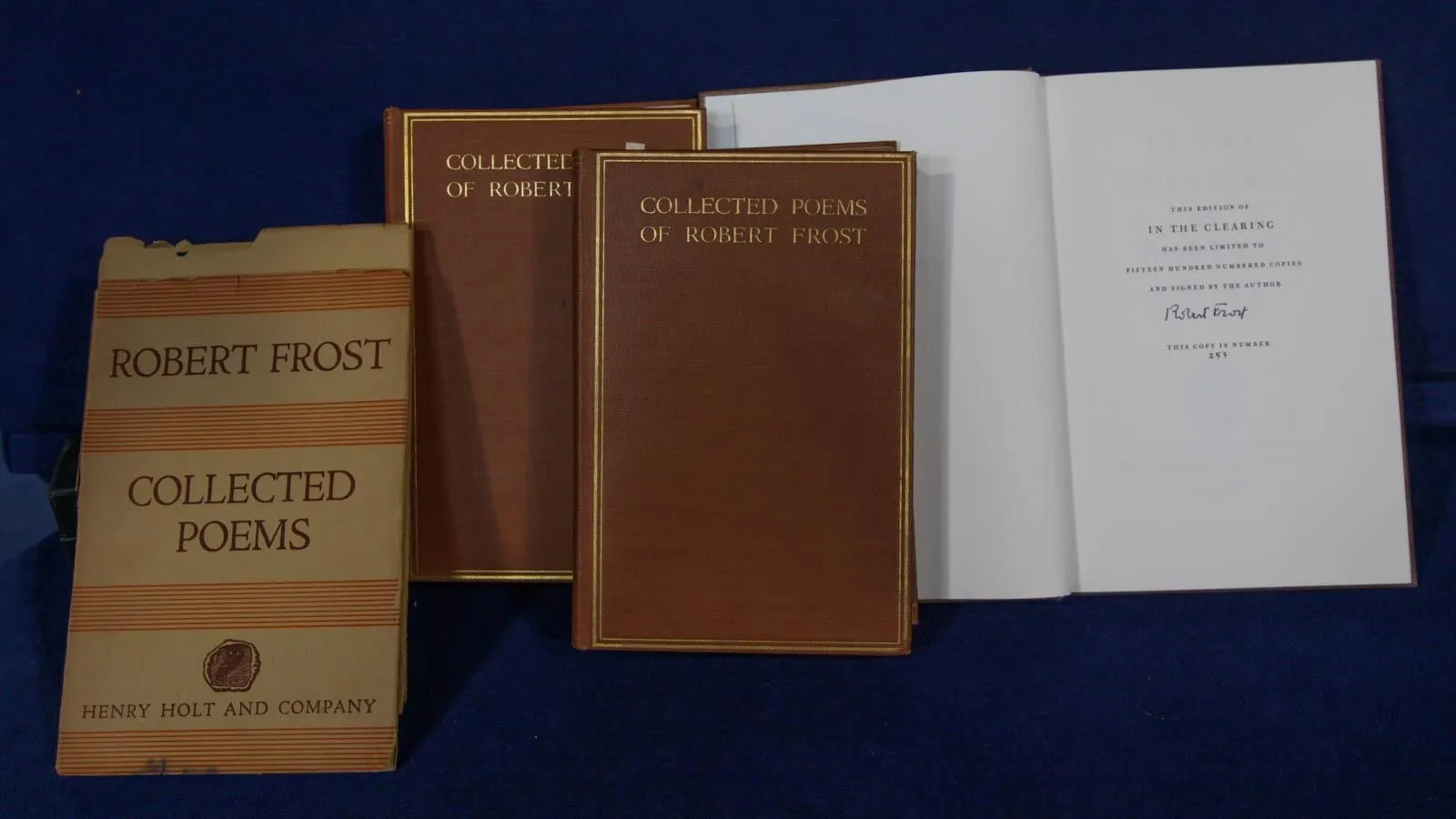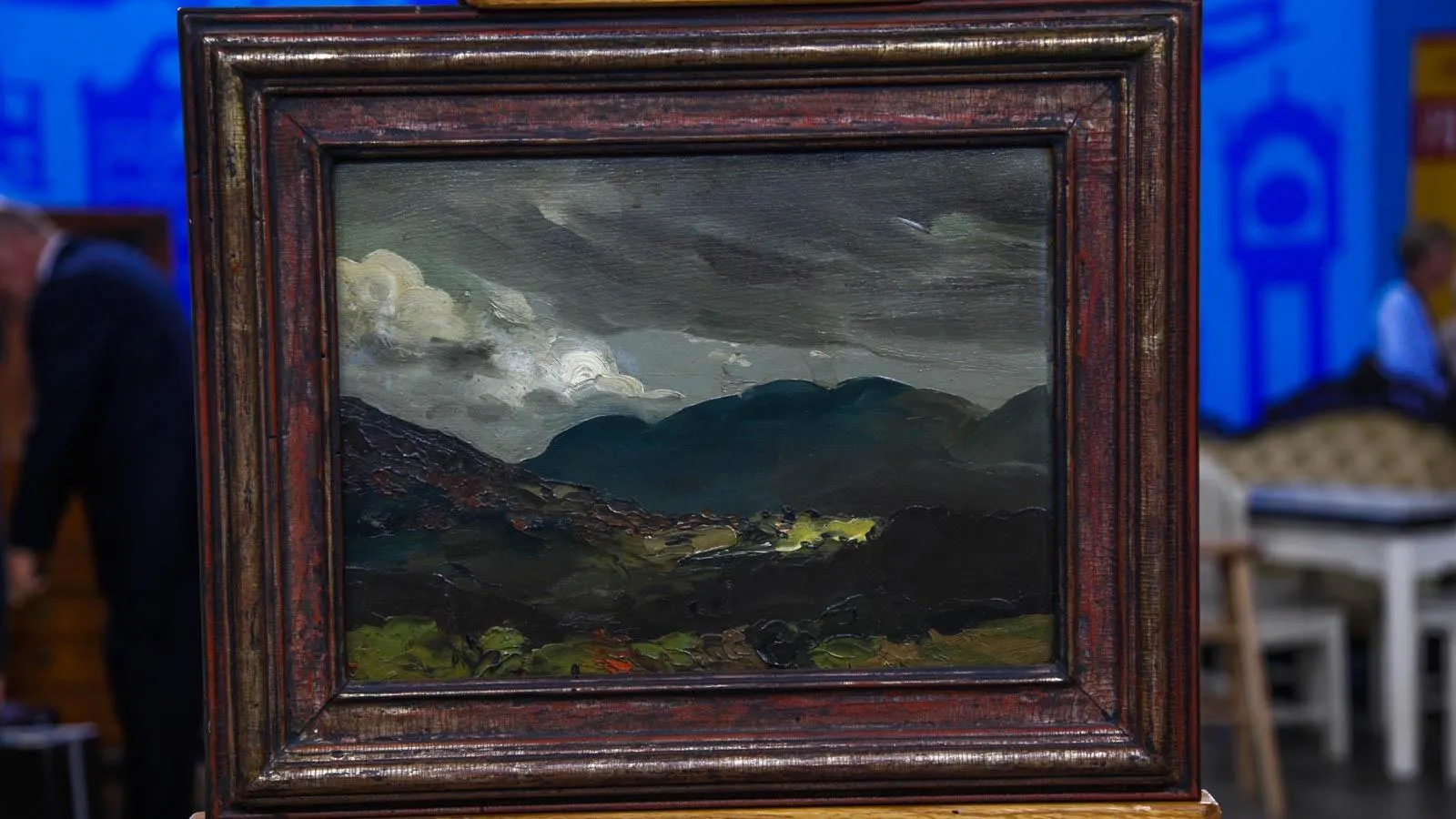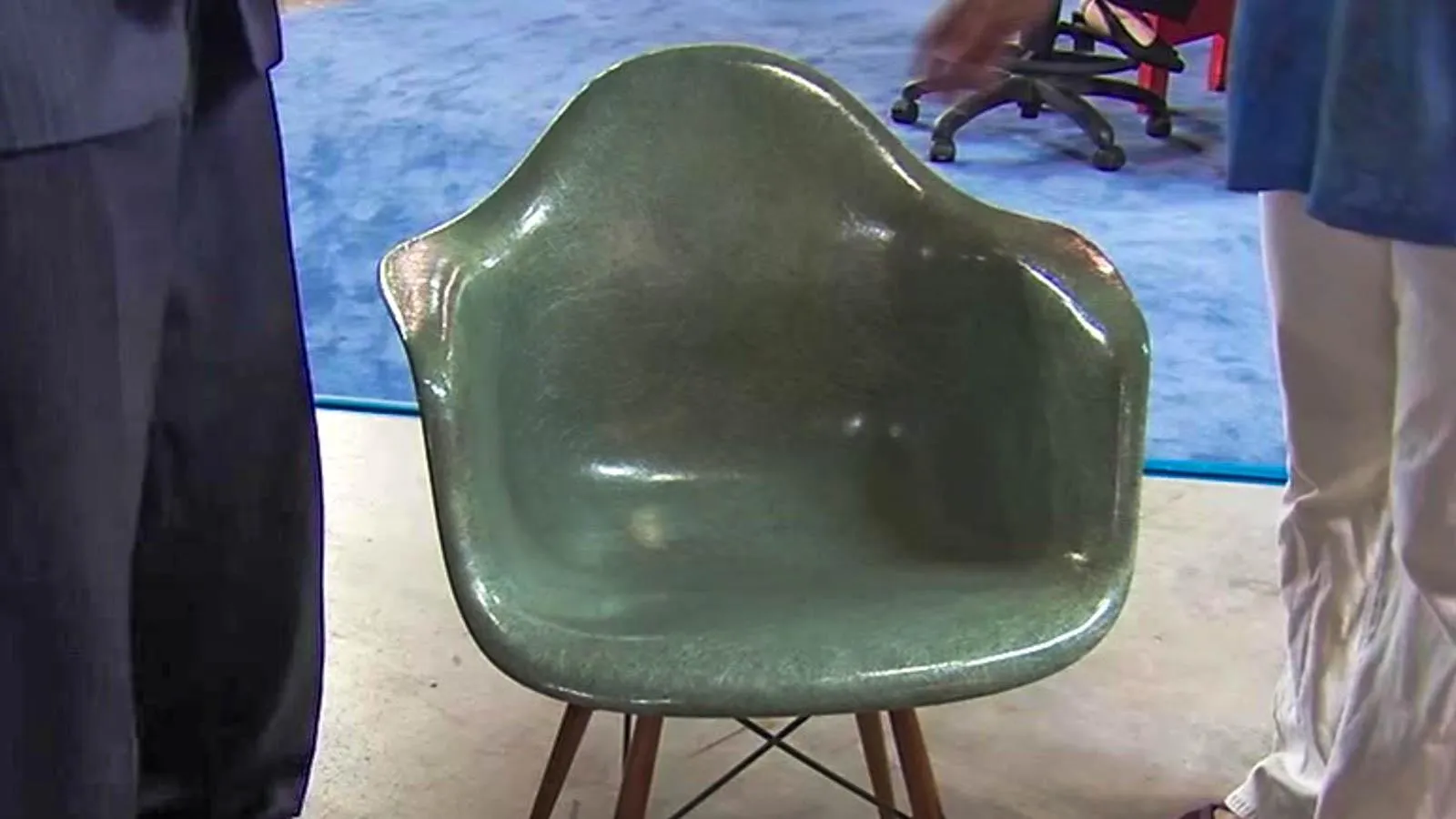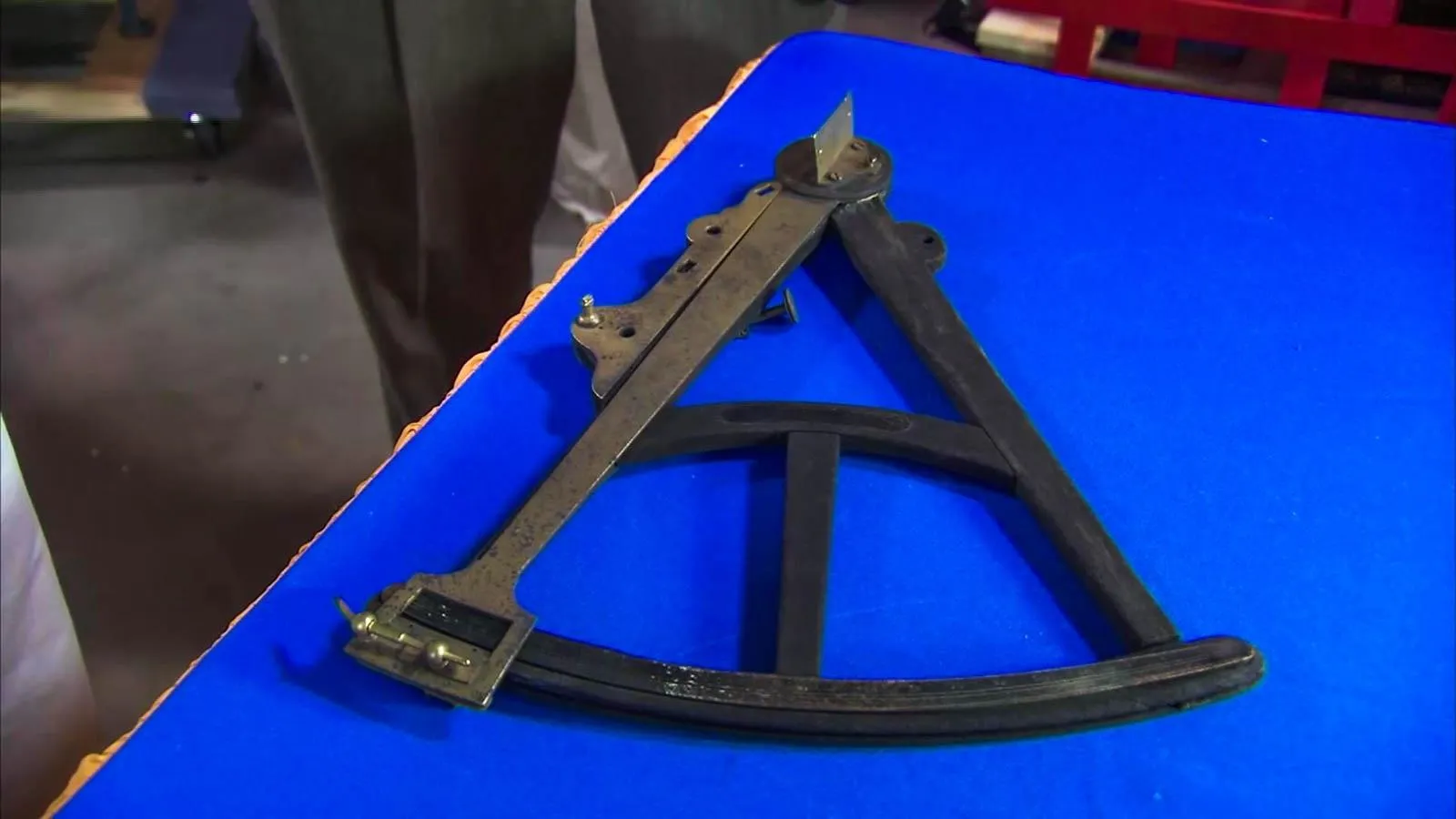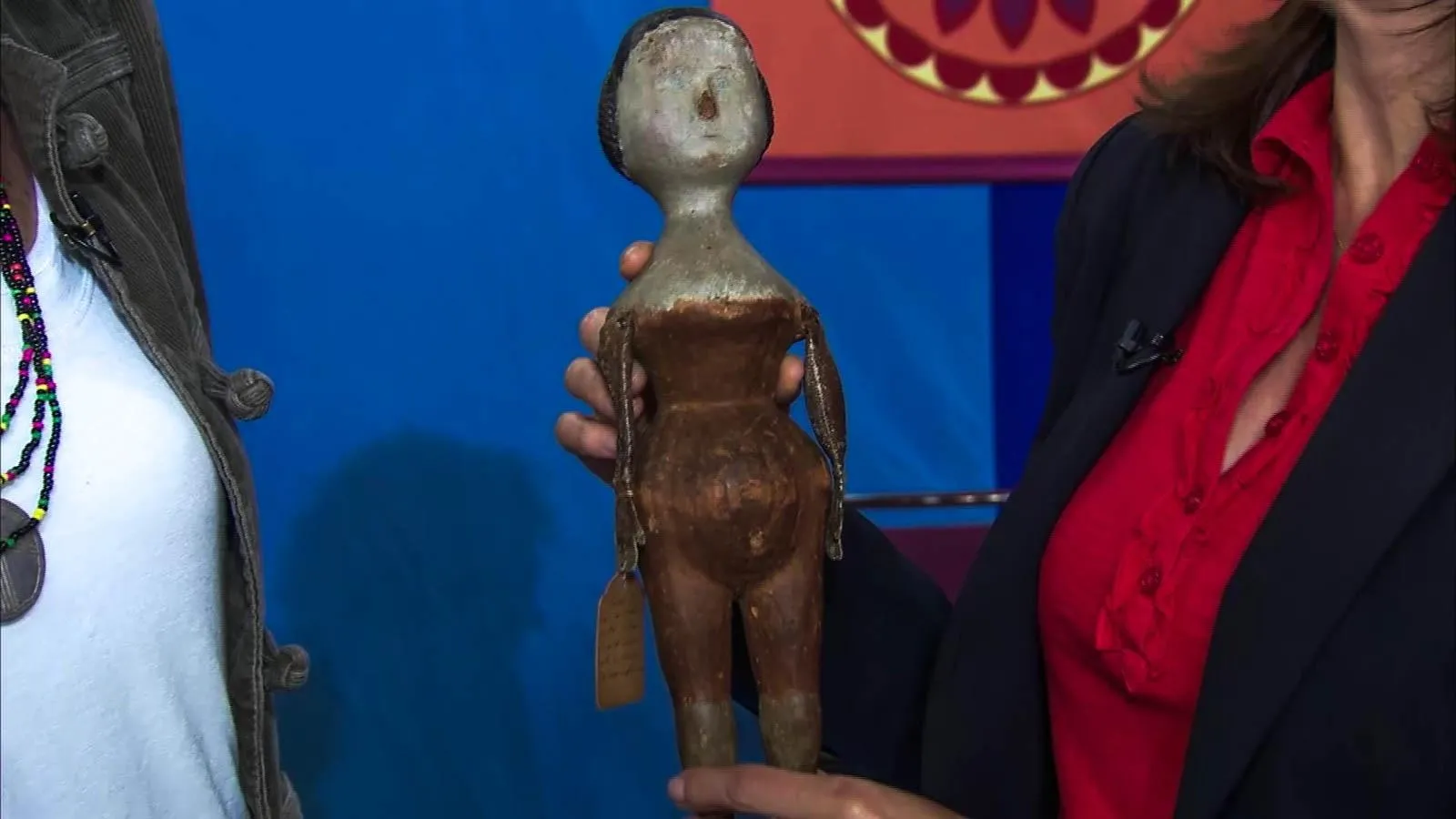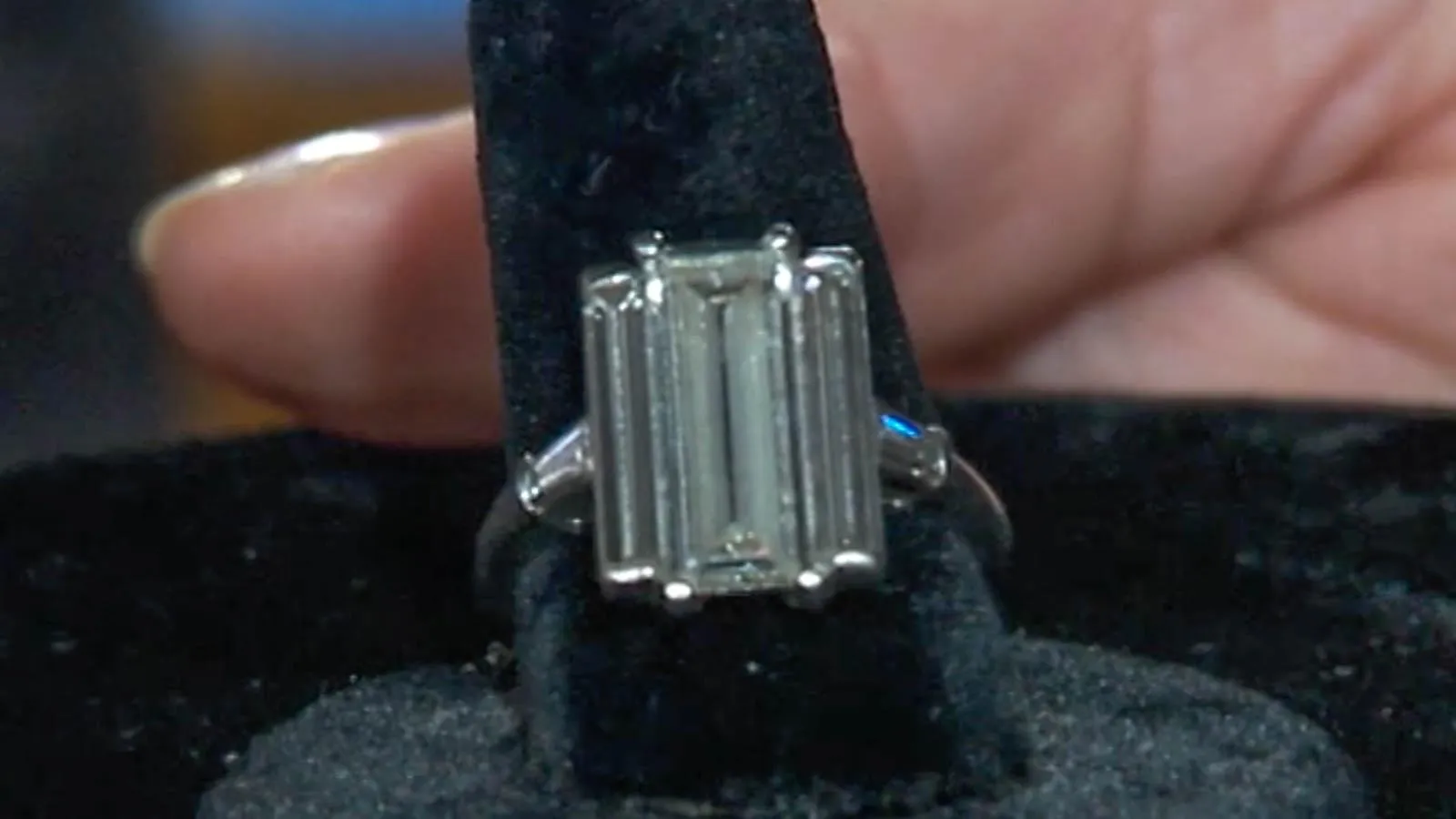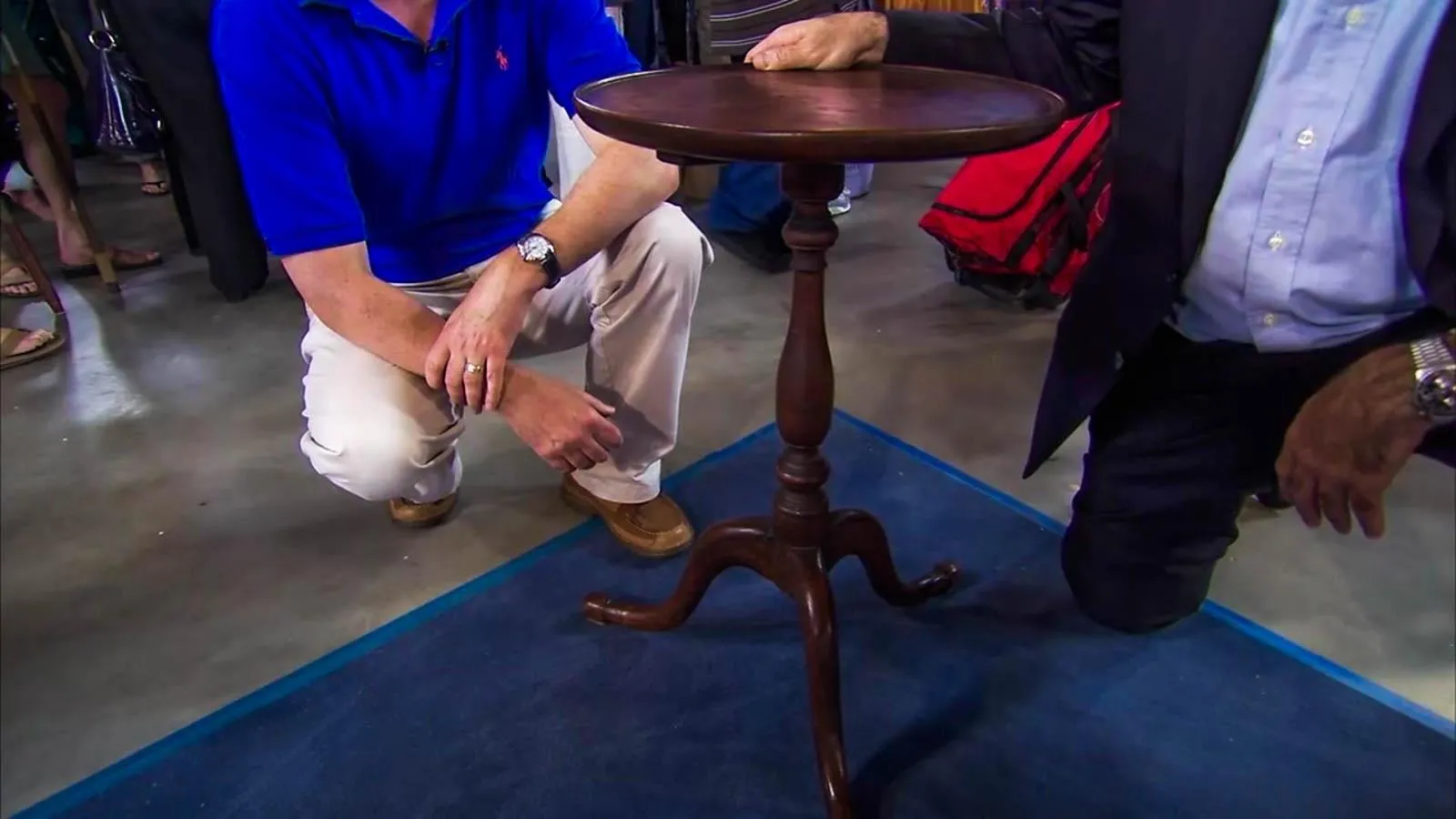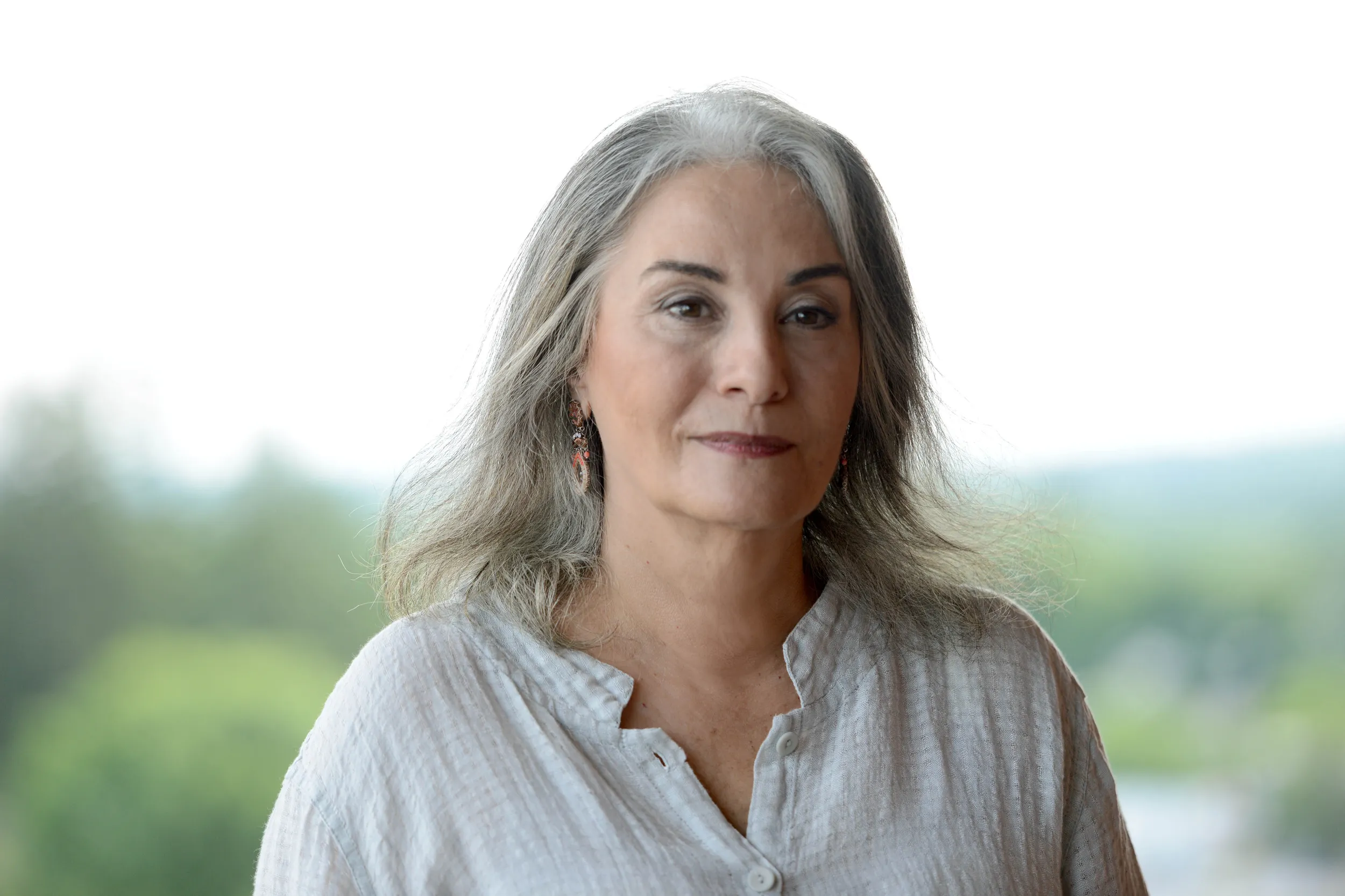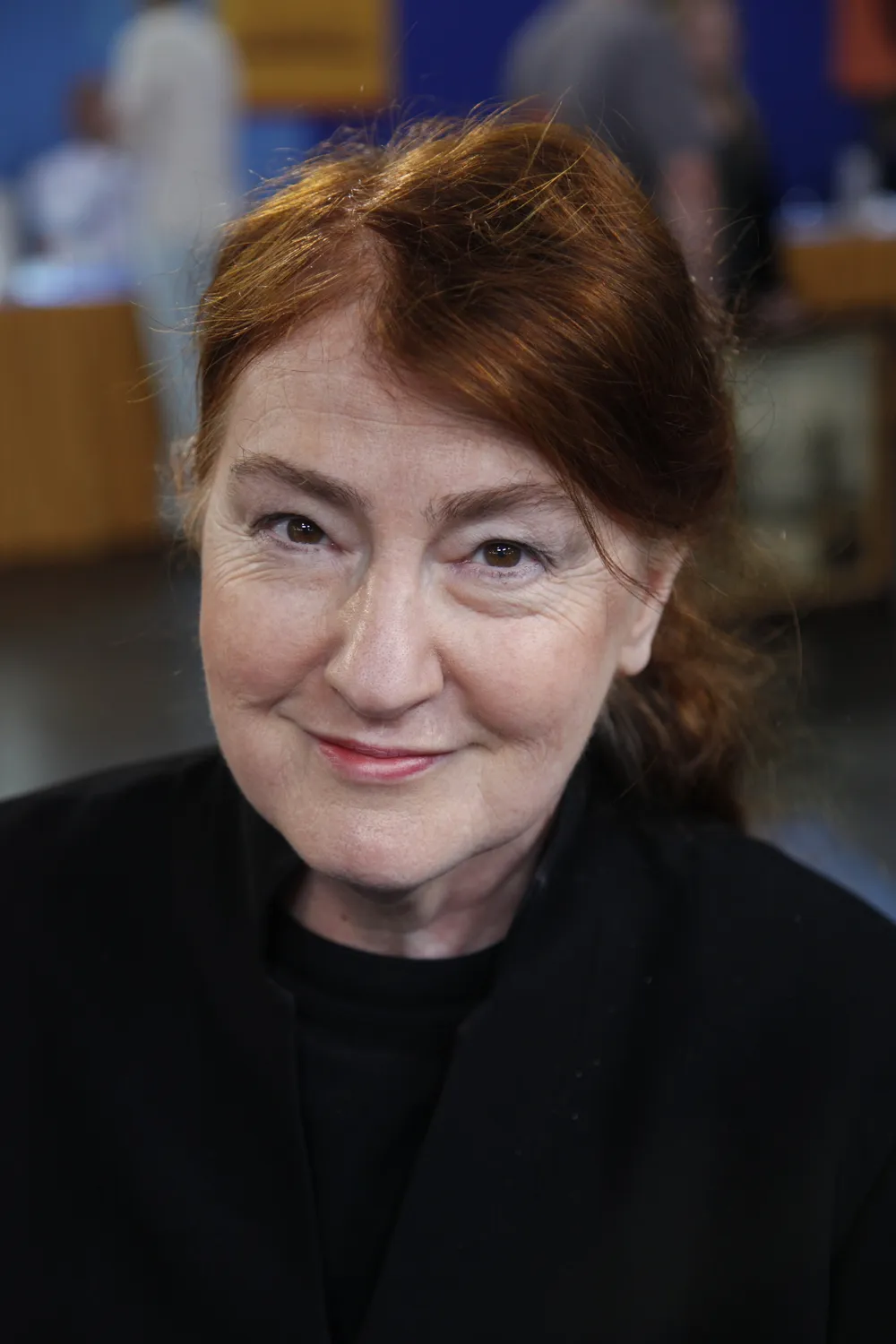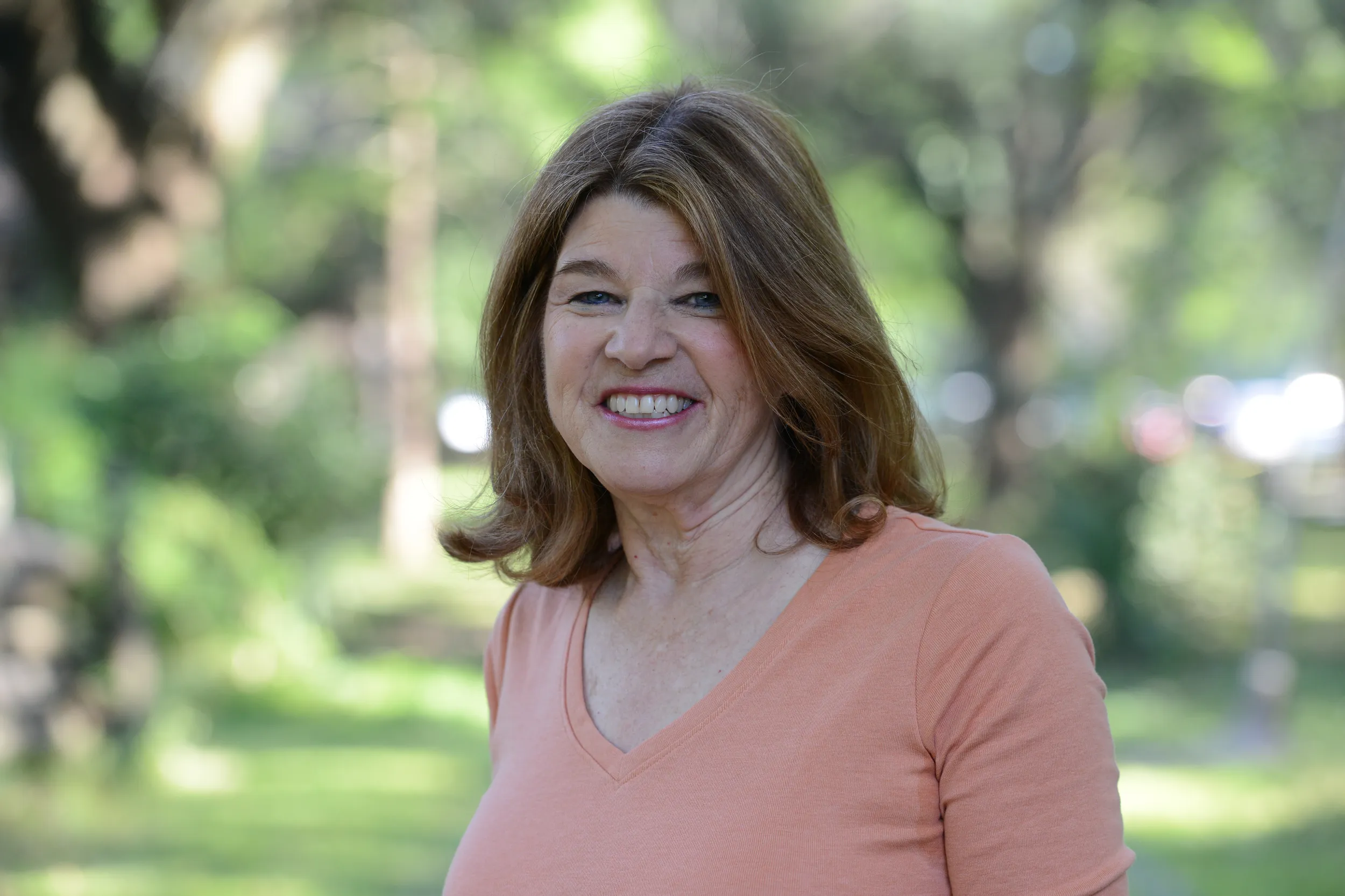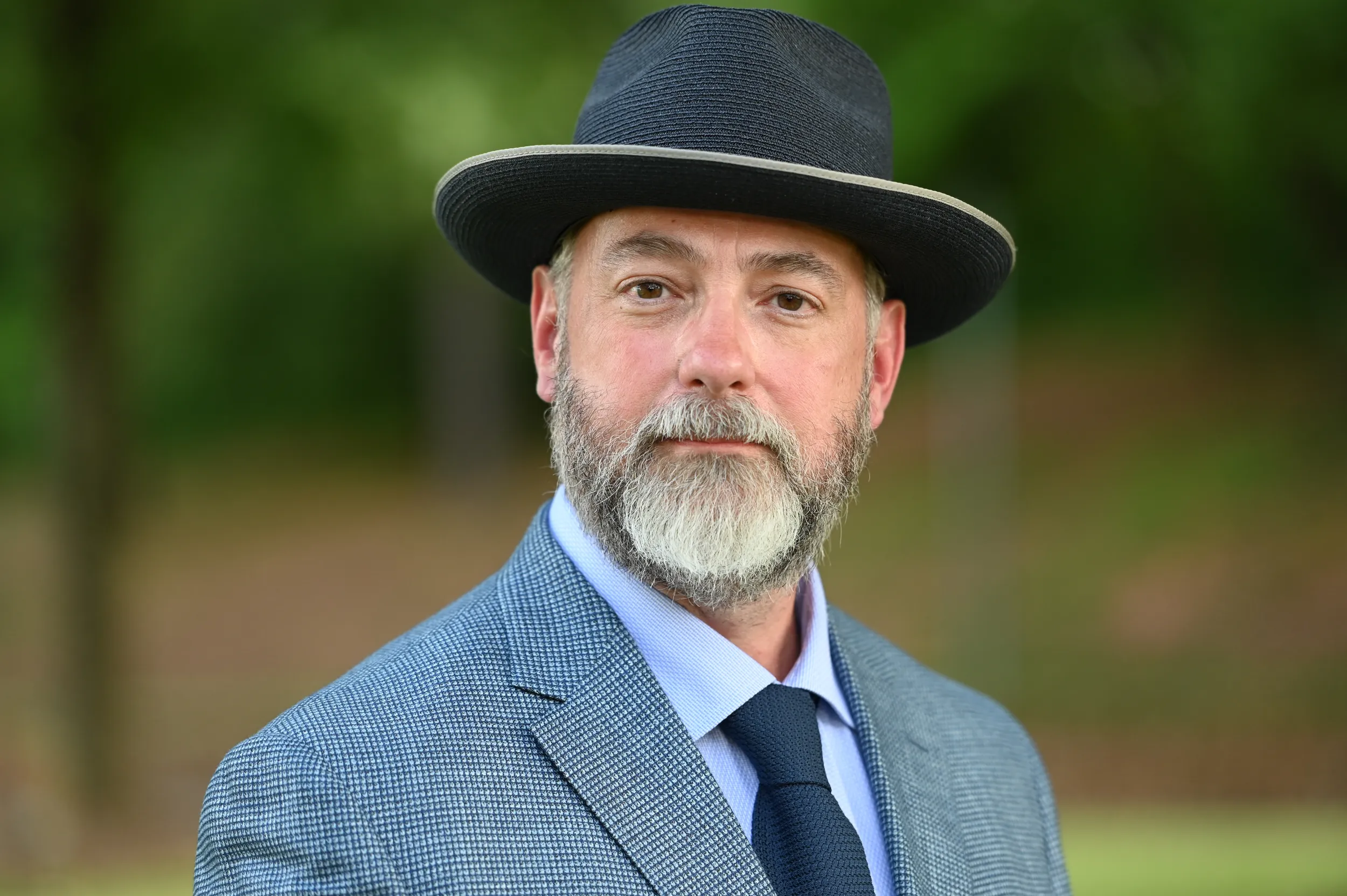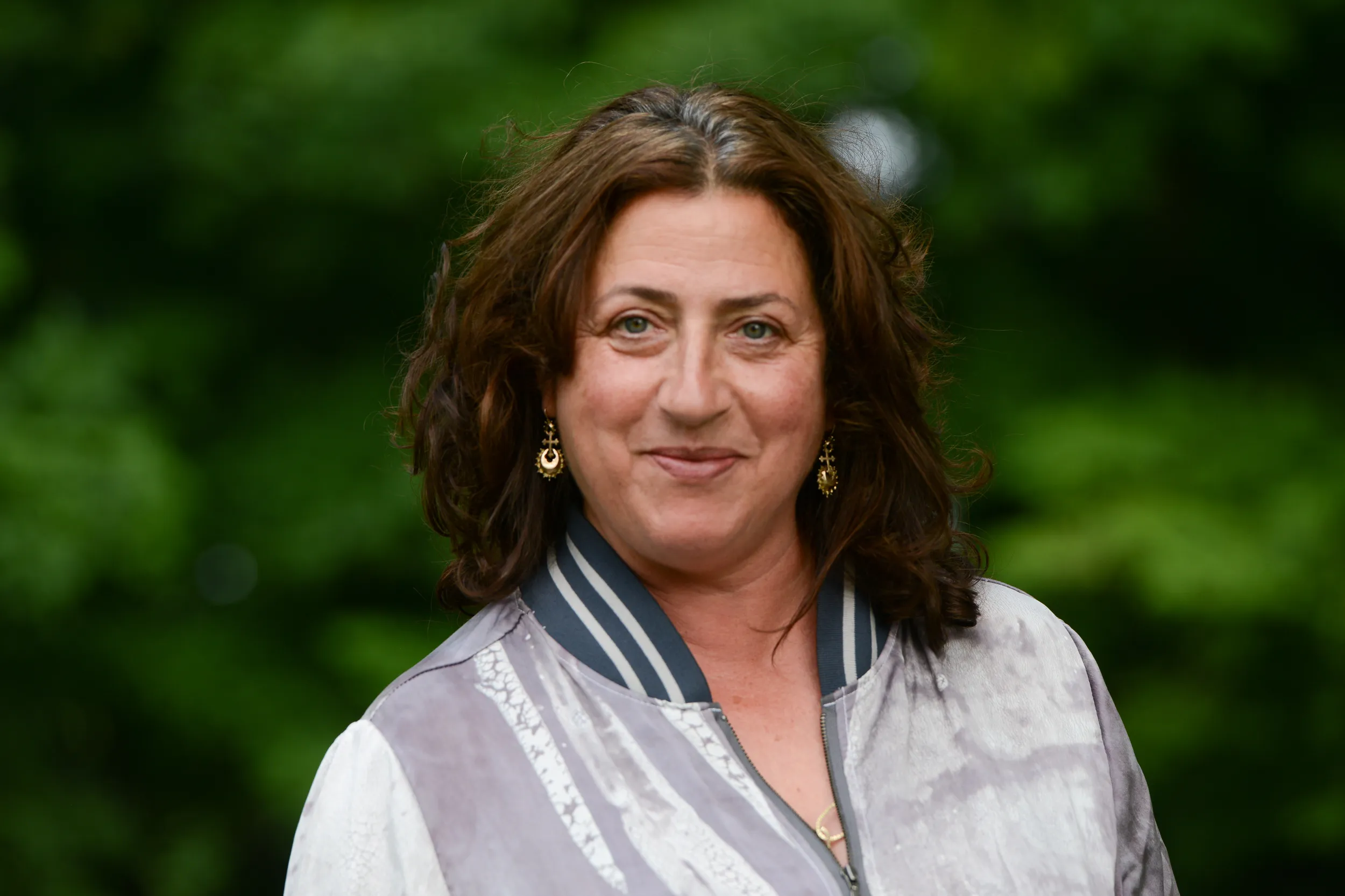GUEST: As a child I used it to put my important things in it. And I put them in there, and I pretended it was money.
GUEST: It was the day after Picasso died, and my husband said, "If we're going to buy a Picasso, now is the time to do it."
HOST: In 2009, ANTIQUES ROADSHOW appraisers were dealing out wins in Atlantic City.
GUEST: That's fantastic.
GUEST: What?
APPRAISER: Yes.
GUEST: What?!
APPRAISER: Yes.
GUEST: Oh my god! You're kidding! Oh my god!
APPRAISER: I, I-- I, I'm definitely not kidding.
GUEST: Oh!
GUEST: Oh, that's fantastic.
GUEST: Holy smokes, that's amazing.
HOST: We return 15 years later to gamble on which treasures have held high or gone low in Monopoly City. Let the games begin.
GUEST: Well, it's a watch that has been handed down through my family from an ancestor named William Cooper. He became the Supreme Grand Commander of the Sovereign Grand Council of the Ancient and Accepted Rites of the Scottish Freemasonry, the, uh, Prince Hall Division in New Jersey. It eventually went down to... passed down to my great-great-uncle right here, William Davis, and I think that's the watch fob right there that you can see. And he eventually willed it to my father.
APPRAISER: So has it just been sitting in the bank, not really being used?
GUEST: It's-- it's been sitting in a safe for a long time. But every once in a while we pull it out to enjoy it.
APPRAISER: He was born in 1828, and this is from your family bible.
GUEST: That's correct.
APPRAISER: The book is done on the hundredth anniversary of this Masonic order. Inside in the first couple pages it talks about all the original officers in the commandry.
GUEST: Mm-hmm.
APPRAISER: Your ancestor was one of the first African American 33rd-degree Freemasons in the commandry. He was given the watch as a presentation by the other members in December 11, 1876. The watch was made by the American Waltham Watch Company in Waltham, Massachusetts, and it was made in 1871. It has an engraving which is dated 1876 that he was presented by other members of the commandry. There's an amazing engraving, which has a crest of the 33rd degree of Freemasonry. The watch is made out of 18-karat gold. It's literally in unused condition after 140-some years. It's a lever set, which means to set the time, there's a little lever on the dial, and that lever pulls out. You then adjust the time on the crown, and you push the lever back in. This is an amazing piece of Americana. It appeals to a lot of different collectors. It appeals to watch collectors. There's a lot of Masonic collectors in the country. It also appeals to African- American collectors. A solid gold watch from the mid-19th century presented to a 33rd-degree African American Freemason is a very, very rare find. It also comes with a beautiful gold chain, a gold fob, and a retractable gold pencil from the 19th century. It would easily sell in the $6,000 to $7,000 price range at auction.
GUEST: Wow.
APPRAISER: Although, since obviously it's been in your family for…
GUEST: Right.
APPRAISER: many, many generations, you would want to have an insurance appraisal at least in the $10,000 price range. This is just an unbelievably gorgeous watch an unbelievably fabulous provenance.
GUEST: That's fantastic.
GUEST: I bought it at a country auction, um, 25 years ago.
APPRAISER: And where was that?
GUEST: In Ireland.
APPRAISER: In Ireland. Well, it's from quite a far distance from Ireland. It's actually Tibetan.
GUEST: Oh.
APPRAISER: It's carved iron, and it's carved and pierced with a motif of dragons, foliage, and flames.
GUEST: Okay.
APPRAISER: And then on it, on certain places, you can see where there was a trace of gilding. Well, originally that entire box was gilt. It was all covered with gold.
GUEST: I see.
APPRAISER: It had been fire gilt. And the box is also quite old. It's 16th century.
GUEST: Oh, my God.
APPRAISER: It originally had a leather lining...
GUEST: Okay.
APPRAISER: And it contained probably either a porcelain or a jade bowl that was inside of it.
GUEST: Oh, okay.
APPRAISER: These kind of things were very high-status objects, because you also figure an object like this wasn't something that you just churned out in an afternoon.
GUEST: Yeah, I see.
APPRAISER: It was a major production. And being a major production, it was something that could only be afforded by the wealthiest people, the nobility or Tibetan Buddhist clergy.
GUEST: Wow.
APPRAISER: What did you pay for it?
GUEST: £75.
APPRAISER: Well, that turned into a good deal. This material comes from a place called Derge in eastern Tibet.
GUEST: Okay.
APPRAISER: And from about the 15th century on, they did this kind of work.
GUEST: So, um, when you say its- its carved, this, this was it a forged piece, and then...
APPRAISER: Forged and then carved with a chisel and a hammer.
GUEST: My God. And do you think it was used for something else afterwards? Because I always thought it was a cooker of some sort.
APPRAISER: No, it was probably always used to contain a bowl.
GUEST: Okay.
APPRAISER: And would have had leather straps holding it together. Did you have any idea about the value?
GUEST: Uh, no, sir. I just bought it because it intrigued me, and basically it sat on my fireplace for the past 15 years, and, um, actually it was an afterthought, bringing it here.
APPRAISER: Wow.
GUEST: And I've-I've always wondered what it was. I thought it might have been Chinese, but, um, Tibetan, that's amazing.
APPRAISER: The quality of the workmanship is really, really fine, though it's quite worn. But that's kind of to be expected with the age. But I would expect at auction for this box to sell for about $10,000.
GUEST: Oh, my God. Holy smokes, that's amazing.
APPRAISER: Uh, it's very rare material.
GUEST: Oh, thank you so much.
APPRAISER: There's very little of it around.
GUEST: Thanks very much.
GUEST: Well, I brought in a, a rifle that I'm pretty sure is from the Civil War era. I've been confused about it for a long time. I know Sharps is the manufacturer. And I took it to, um, an antique dealer that was a friend of the family and I used to cut his lawn for him. And I said to him, "What have I-- what have I got here?" And he said, "Well, I'm not quite sure. It doesn't seem to be what the rest of them are." And I kind of thought, "Oh, all right." I always thought maybe if I went to Gettysburg, I'd drag it along with me, and I haven't yet, and so here I am.
APPRAISER: They were made by Christian Sharps in Hartford, Connecticut.
GUEST: Okay.
APPRAISER: They made over 100,000 Sharps carbines, but this one is a special one. They only made about 263 of these.
GUEST: Wow.
APPRAISER: They're made in 1856. They're known as a Sharps slanting breech naval rifle.
GUEST: Oh.
APPRAISER; They're a rare gun..54 caliber. And they're just an odd gun. Did you ever notice what's on the underside of the barrel down by you?
GUEST: I did, and the man that was speaking to me said it may be for a bayonet, but then he said, "On the other hand, it's too short. So did they cut the barrel down and then reattach the bayonet?" And I said, "It doesn't look like that much of a botch job to me."
APPRAISER: And it came from the factory that way.
GUEST: Okay.
APPRAISER: That is for a bayonet. It had a big, massive saber bayonet that could be used as a saber, or you could attach it to the end of the gun and be used as a bayonet. But when you put it on there, the weight of it would almost tilt you over. That's one of the neat characteristics of this gun. Another, did you ever notice this door?
GUEST: Yes, and I tried to pry at it...
APPRAISER: Mm-hmm.
GUEST: And it didn't happen real well, and I thought, well, I know enough to leave well enough alone.
APPRAISER: Well, I'm glad you left it alone, because most of the time, those doors are missing. And this is what those are for. We cock the hammer back, we lower the door, and it has an open space.
GUEST: Yeah.
APPRAISER: These guns generally run on a percussion cap.
GUEST: Right.
APPRAISER: You put it individually each time on the nipple every time you want to fire it. They made a system developed by Edward Maynard that worked with like a little cap gun roll. And it would feed the roll of caps underneath the hammer every time you cocked it back. And watch this. It still works. And it is a navy rifle. On the top of the barrel, we even have a little naval anchor.
GUEST: I never noticed it.
APPRAISER: It's so small. I love the flavor. I'm so proud you never cleaned this up. It's got a knee-deep patina.
GUEST: Yeah.
APPRAISER: It's just beautiful. If you're going to insure it, I would say that we would need to insure it for at least $7,500.
GUEST: All right. Well, I guess I better get on that right away.
GUEST: This was my grandmother's chair. It was in her apartment as long as I can remember. There's a tag on the back that said it's Eames and Zenith.
APPRAISER: You're absolutely right, it's an Eames chair. This chair was made probably about 1950, 1951. As far as value goes, it's probably worth about $1,500 to $2,000 in today's market. Fantastic chair. I think it really captures the spirit of the times.
GUEST: I was the first person at a yard sale. It was $25, and I didn't even argue, I just bought it. And the woman said it was inexpensive because she didn't have the shade for it. And I thought it was from the '30s because of the cord, and I thought maybe the glass was like a fluorine glass, which I know Tiffany. So I was hoping it was a Tiffany or a Handel, but I couldn't find any marks on it.
APPRAISER: Well, fortunately, you allowed me to take this apart earlier. You were very kind about it. And the reason I wanted to take it apart is because I suspected that it was Tiffany, and, lo and behold, yes, it is a Tiffany.
GUEST: Oh, my God.
APPRAISER: It's called an arrowhead, and it's a bronze and a mosaic base. And this was a very early piece. It was originally intended to be used as an oil lamp, and at some point, maybe in the '30s, I don't know, someone put on this base on the bottom and put this very strange (laughing) socket on. Didn't do the best job. Ordinarily, when somebody would rewire something like this, they would actually put the wire up through the top so that you wouldn't drill it. And by drilling it, that's not such a great thing. We don't have the shade. But despite all that, um, I would put a value of this at $50,000.
GUEST: What?!
APPRAISER: Yes.
GUEST: What?!
APPRAISER: Yes.
GUEST: Oh, my God, you're kidding!
APPRAISER: I...I…I…I'm definitely not kidding.
GUEST: Oh, my God, oh, my God. Oh, my God.
APPRAISER: You're a good shopper
GUEST: Oh, my God!
GUEST: I inherited it when my mother died. But as a child I used it to put my important things in it. And I put them in there, and I pretended it was money.
APPRAISER: What you have is an 18th century, circa 1740 to 1770, walnut Queen Anne chest. And it was called, really, a valuables chest. Let me just pull out a drawer and just show you what you have here. This is actually cedar, which should keep away insects. And on the side this is poplar. You see that green wood? Those two woods were used in Philadelphia, Chester County, all those areas near Philadelphia, in the Queen Anne period on furniture. See those wonderful dovetails?
GUEST: Yes.
APPRAISER: And look at the back of the drawer. Here are the original post and nut. So you have the original Chippendale brasses on this. You have this overhanging cornice, wonderful, molded drawers, three over two, over a graduated set of three. Now, if I take this top off and we look at the bottom of this chest right here, you can see that from the witness mark, the light poplar...
GUEST: Right.
APPRAISER: it shows that this is exposed to air, and this is not oxidized. That means this always had a base like this on there.
GUEST: Okay.
APPRAISER: It didn't have bracket feet at one time. That's important. It always had a base. The base would have looked exactly like this. But this is not an old enough base. I'm sorry to say that. It was done 100 years ago.
GUEST: Okay.
APPRAISER: Okay, so it's nothing you did or your parents. There was something lovingly done. Right here on the back, if you look at the tool marks, you see these chatter marks right here?
GUEST: Yeah.
APPRAISER: That's from a machine tool.
GUEST: (chuckling): Oh-oh, yes.
APPRAISER: It wasn't invented in the 18th century. Also, if you look on the back side of this-- all the edges are so sharp you can cut yourself. Feel the edge of that now. Run your hand on that. See how all that's beat up and... that's from 200 years of use. That's why we don't refinish pieces, we don't clean them away. And that's why this is such a treasure. I was so excited. You made my day, okay?
GUEST: Yes, and you made mine.
APPRAISER: As a wonderful piece that has a replaced base, it is worth at auction probably $5,000 to $8,000, in that range. Now, if this had its original base, it would be worth in the range of $60,000 to $80,000.
GUEST: (laughing) Oh-ho-oh.
GUEST: It was the day after Picasso died, and we spied these two things, and my husband said, "If we're going to buy a Picasso, now is the time to do it."
APPRAISER: You're kidding me, so you got them the day after he died?
GUEST: The day after he died.
APPRAISER: Now, typically, after an artist dies, particularly one as prominent as Picasso, the prices go up. So when you went to this gallery, had they marked the prices up on this?
GUEST: Maybe they didn't know that...
APPRAISER: Did you know? (laughing)
GUEST: Maybe he didn't know that they were even dead
APPRAISER: They hadn't figured that out yet, so you were ahead of the curve on this, huh?
GUEST: Exactly, exactly.
APPRAISER: Very good. It is indeed a hand-signed lithograph by Picasso. But a lot of people might not know that he also made ceramics. I didn't until then. This is after he's already a famous artist, well, well into his career.
GUEST: Typical Picasso. (laughs)
APPRAISER: But he never slowed down. Let that be a lesson to us all, never slow down. So, to put the two together, I think you'd see similarities in style and workmanship, but of course, two completely different media.
GUEST: Right.
APPRAISER: At auction, you have about $23,000 worth of Picassos here.
GUEST: That's very favorable. Better than the stock market, I'll tell you that. (both laugh)
APPRAISER: So I would take very good care of them.
GUEST: Even better than I have been. (laughs)
APPRAISER: (laughing) Good. Thank you very much for bringing them in.
GUEST: Thank you.
GUEST: When my husband's parents bought their new home, this chandelier was left by the previous owners. And after the sale was closed, I think they had regret that they had left it and asked my in-laws if they would return it to them. But my mother-in-law had a beautiful antique chandelier of her own so she turned them down and gave it to us as a gift.
APPRAISER: Oh, well, once a sale is made, a sale is made.
GUEST: Yes; when my mother-in-law gave it to us, the height of the piece was, uh, taller than the room would accommodate. And she took it to a business that dealt with antique, um, lighting. And when they removed the piece that we needed to fit the height, they told her it was an antique Limoges chandelier. And they also told her, based on the wiring on the exterior of the arms of the chandelier, that they thought it was a gas chandelier converted to electric.
APPRAISER: Here's the spacer that you remarked on. And there is a mark on the base that says simply "Limoges, France."
GUEST: And that helps you date it?
APPRAISER: It does help us date it, but the mark is not really what we need to date it. We can do it in other ways. It must have been quite a production to bring it here today. Was it hanging up?
GUEST: It's in our dining room, and the electrician that we had hired didn't show up. So my husband said, "We can manage this." And an hour later, all four members of my family-- my daughter held the flashlight. My husband ended up having to use a hacksaw because one of the screws was stripped. My son and I are under the chandelier sort of you know, because it's fragile, and we were worried about it. So, it was quite the ordeal to get it down, and my son, who's 15, said, "Mom, if you're not on TV, we're disowning you." (chuckles)
APPRAISER: Well, don't worry about being disowned. It's made of two materials-- porcelain and then gilded metal. It's not, I'm afraid, hand painted. All of the decoration in the panels is transfer printed, which is already an evidence that maybe it's not quite as valuable or old...
GUEST: Old.
APPRAISER: as important as you might think. This concept of the wires being attached to the arms is sometimes evidence of rewiring a gas fixture, and gas fixtures tend to be at least 100 years old or more. This is not. It's also done on fixtures that are inexpensive. This is not a good sign in this case. Limoges is a prestigious name. Limoges has been a center of porcelain manufacturing for 150 years or more. And they made some great things there. But they use the name today often more as a prestige term than anything else. And the quality of the porcelain is really not very strong, as indeed generally the quality of the entire piece. I'm afraid, in this case, despite all the expectations you may have had and all the trouble your family went to to bring it here, if it came up at auction, I would be very surprised if it sold for more than a few hundred dollars.
GUEST: That's interesting.
APPRAISER: I would have thought between $300 and $500 would be the correct estimate at auction.
GUEST: Well, that helps explain why they might leave it, that it didn't have great value. But it was free to us, so that's... I'm, I'm glad to know.
GUEST: I've actually had it for a number of years. It was originally my grandmother's, and I remember, as a kid growing up, I'd always see it sitting in the den and as I got older, I actually grew to appreciate it more, and then when she had passed away, she had left me a couple of paintings, and this was one of them.
APPRAISER: Have you done some research on it?
GUEST: I've done a little bit. I assume that the artist is Alberto Pasini, and I knew he was an Italian painter, kind of roamed around and did a lot of, I guess, daily life pictures.
APPRAISER: Yeah, I think by general consensus, he's probably the leading Italian artist to work in the Orientalist manner.
GUEST: Really?
APPRAISER: And by that, I mean, using subject matter from the East, from North Africa. And he traveled there extensively. He was from Italy originally and studied in Parma, and then moved to France, where he knew artists such as Fromentin, he knew Jules Duprés, Théodore Rousseau, was associated with the Barbizon school, and he learned from all of them. But in the middle of the 1850s, when he would have been, I think, in his 30s, he had some financial problems, apparently. And he decided to go off with a French expedition to the Near East. And he traveled to places like Saudi Arabia, Yemen, he was in Turkey. He traveled around pretty extensively and really fell in love...
GUEST: Okay.
APPRAISER: with what he saw there, and that became his subject. He loved the area so much that he lived in Tehran for two years in what was then Persia and was even commissioned by the shah to do paintings.
GUEST: Really?
APPRAISER: And this painting here, it's hard to determine where exactly it might be. He did do a lot of work in Constantinople, so it's possible that it's of Turkish origin. I couldn't really say. But it really is an exquisite little piece. It shows his mastery of draftsmanship. He's a really wonderful, subtle colorist. The green going around here, and then picking out the red and the little red fezzes here. He just sets them off beautifully, and that's fairly typical of his work. A little muted ocher, and then there's a sensitive scumbling in there. And some of the oil paint, which is what it is, has almost been applied in thin washes like watercolor. For many people, - it may not be as commercial as some of his other works. They might want a little bit of blue sky in the top or a bit more light.
GUEST: Mm-hmm.
APPRAISER: But I actually think it's just a great, subtle, understated little painting.
GUEST: (chuckles)
APPRAISER: And I would think at auction, I would feel very comfortable with an estimate of $30,000 to $50,000.
GUEST: Really?
APPRAISER: Yeah.
GUEST: (laughing) Wow!
APPRAISER: Yeah.
GUEST: I had no idea.
APPRAISER: I don't think you would want to insure it for much less than $70,000.
GUEST: Really?
APPRAISER: Yeah.
GUEST: (laughing) Wow. Wow.
GUEST: About ten years ago, we had a really fierce storm, a nor'easter, and the following morning, I went out on the beach, and I found this floating in the surf, and I pulled it out. And I've been trying to find out ever since what it is.
APPRAISER: Well, I'll tell you, it is my honor to answer that question for you. This is what is called a Hadley's Quadrant.
GUEST: Oh.
APPRAISER: The name of the maker is Radford in London. This instrument dates from around 1710 to 1722.
GUEST: Oh my gosh.
APPRAISER: And what a find.
GUEST: Yes, yes.
APPRAISER: Now, value-wise, you're probably looking at around $1,000.
GUEST: Oh my goodness.
APPRAISER: But believe it or not, its value is based as much on the story as it is who made it and its condition.
GUEST: Well, I got the doll back in, I'd say, the early '60s. My grandmother was moving. It was up in her attic, and she said that if I wanted to have anything, I could take it. It says on it that it's 160 years old from Cape Cod and it's made by a sailor.
APPRAISER: It's an interesting piece to us. We love it as folk art. It's one of the best carvings we've seen here in a long time. We love its spare quality, the dry paint, the hair. What we love in folk art is to see original condition. Do you have any idea of value?
GUEST: None.
APPRAISER: Well, as a doll, as a sea captain's doll in the 19th century, it would be worth $2,000 to $3,000. As a piece of folk art, it's a bit different. We think of it as sculpture, as something you look at, not something you would dress up, and it would be worth probably $8,000 to $12,000.
GUEST: Oh, my God. (chuckles)
APPRAISER: It's a great piece.
GUEST: Back in 1950, my father was the eastern regional representative from Williamsport for Little League. And we used to go to the World Series every year. I was nine years old in 1950, and Carl Stotz, who founded Little League, introduced me to Cy Young, and from that point on, I had a relationship with him. He and I would sit in the lobby of the Lycoming Hotel for the next five years and talk. In 1955, I was up there for the World Series, and I had just gotten a Brownie box camera, so I asked Cy if I could take his picture. He said, "Well, not now. Come up to my room in about a half-hour." So I went up to his room, and he had gotten potato chips and pretzels and Coke, and he sat in the chair and I took the picture, and he signed the baseball, he signed the book, and he signed two 3 x 5 Little League cards. And it's probably the last picture of him taken alive, because in November of that year he died. And, uh, he just was a gentleman.
APPRAISER: Wow, that-that is just so wonderful. And, of course, he was, he was a pitcher from 1890 to 1911, the greatest pitcher by wins. Also had the most losses.
GUEST: Yes.
APPRAISER: And he was elected to the Hall of Fame in 1937, the second class of the Hall of Fame. He passed away in 1955. In 1956, baseball created the Cy Young award, which is granted annually to the, uh, best pitcher, first in all baseball and then, several years later, in both leagues. And we have some wonderful items here which he signed for you and that, of course, you treasure. We have a signed baseball which, uh, you also got a couple of other signatures on there.
GUEST: Mm-hmm.
APPRAISER: Including Robin Roberts, Hall of Famer. But Cy Young really stands out on that baseball. He had a beautiful old-time signature...
GUEST: Yup.
APPRAISER: that you just don't see very often. He loved kids, and he loved doing things for them, the Little League connection, and, uh, he loved signing autographs. That's why his autograph is out there. It's-it's not particularly rare, but it's incredibly desirable. You have a lovely book here, a Little League book, which he also signed for you.
GUEST: Yep.
APPRAISER: And, uh, of course your photograph of him, which shows the distinguished gentleman himself and the, uh, 3 x 5 card which he signed. They're wonderful pieces. As a collection, I would insure it for somewhere in the neighborhood of $5,000 to $7,000, and, uh, it's the type of thing that'll never go down in value, because Cy Young is a name that everyone knows and will know.
GUEST: Yes.
APPRAISER: As long as there's baseball, there's going to be Cy Young.
GUEST: It's a statue that was given to my husband. He's a contractor, and it was given to him from someone that he works with.
APPRAISER: Have you done any research to try to figure out anything about it or...?
GUEST: I know that it was, like, early 1900, and that's all.
APPRAISER: Okay, it is signed, and it's J.L. Gérôme, the French artist. He was born in 1824 in France and really spent most of his career as a very well-regarded and prominent French painter and engraver. And it wasn't until he was about fifty that he really became a sculptor. He exhibited sculpture for the first time at the Paris International Exposition in 1878, and this is just a really great example of his work. As with his paintings, he was very interested in Orientalism and the exotic, and you can really see that in this figure. She does have a title, Woman With a Veil.
GUEST: Ah.
APPRAISER: And you can see from her costume, she's got this sort of elaborate decoration on the fabric and these jeweled belts and this great coloration of her skirt. Do you know what it's made out of?
GUEST: Marble?
APPRAISER: Well, it's made out of marble; it's also made out of bronze.
GUEST: Okay.
APPRAISER: The majority of the sculpture is bronze, and the feet are marble and they've been painted, which is not something that you typically find. The face, again, is, uh, marble and painted and she's missing her left hand. What's interesting about it really is that it's an experimentation. There's a combination of materials. The marble is painted. The bronze is patinated in different colors. It probably dates from the late 1880s, 1890.
GUEST: Wow.
APPRAISER: So, a little bit earlier than you thought. Yeah. This model was produced in three different sizes, and this is the largest.
GUEST: Oh!
APPRAISER: So do you have any idea of what the missing hand... how that impacts value?
GUEST: No, but I could imagine, right?
APPRAISER: Obviously, the best scenario would be if it were to suddenly, miraculously appear and it could be reattached.
GUEST: Okay. Okay.
APPRAISER: If that isn't the case, an option would be to have a professional carve one out of marble to reattach. An example sold recently at auction with an entirely replaced arm, and that sold for just under $75,000.
GUEST: Yeah? Hello. Okay. (giggling) Oh, wow!
APPRAISER: So, with the hand obviously missing, an auction estimate would be between $60,000 and $80,000, in that range...
GUEST: Okay.
APPRAISER: And, you know, it's really, in the scheme of things, a minor, a minor conditional issue, believe it or not.
GUEST: Wow. Wow.
GUEST: Well, these are books that were my mother and father's, all Robert Frost, two first editions. My mother and father were both students, one at Wesleyan and one at Mount Holyoke, and they went together to a reading right when this book was published, and they got these two copies.
APPRAISER: And that was 1930?
GUEST: And there, they both had Robert Frost sign them, "Amherst, 1930."
APPRAISER: The copy owned by your father differs a little bit. If we open it up, it's the opening line of one of his most beloved poems.
GUEST: Oh, it's the-the first line from "Mending Wall."
APPRAISER: Yep, the-the one that ends "Good fences make good neighbors."
GUEST: Right.
APPRAISER: It's got a lot of memorable lines from it. This is the dust jacket for your father's copy. Your mother did more typically what people did in those days, which was to discard it, and would read the book and hold on to the book.
GUEST: Right.
APPRAISER: The book here, In the Clearing, was published in 1962...
GUEST: Right.
APPRAISER: And that was the one that includes his poem for JFK's inauguration. And here it's signed by Frost. Uh, it doesn't have the date, it doesn't have the place, and it certainly doesn't have a line from the poem. It's simply signed on what we call the limitation page, And, uh, it says here, it "has been limited to 1,500 numbered copies signed by the author." So his signature, it's numbered below, number 253. In the hierarchy, it's a different book title, so it-it-it makes comparison, um, slightly difficult, but what's important to note is when books are being signed, it's often for different reasons. This would be something more mechanically done, where he was sitting there, literally signing them...
GUEST: Right.
APPRAISER: probably not in front of them. This one shows up, because it was 1,500 copies. In-in the range of values, at auction, that one would be in the, uh, $400 to $600 range. The first one, your mother had it signed. It was simply signed with a date. That's good. To get a line of-of... from one of his more famous poems, that's, that's better yet, and, ideally, if you could have had him write out the entire...
GUEST: The entire poem? All, all 30 lines, or whatever.
APPRAISER: Yeah, all 30 lines. That would have been even better. I would put your mom's book, without the jacket, with the-the simpler inscription I would value that one at about $800 to $1,200. This one, with the line, I would put an estimate of $2,000 to $3,000 on it. So it's a nice jump in value, as you can see.
GUEST: Okay.
APPRAISER: So altogether, I mean, you're looking at about $3,000 to $4,000 for the group. If everything else was equal, the dust jacket would add...?
GUEST: No, it wouldn't. The thing is, when a book is inscribed, that overrides a thing like a dust jacket.
GUEST: This is from my great-uncle, handed down to me from my mother. And this is about my uncle, Charlie Trinkard, who was killed as a pilot in 1917 as part of the Lafayette Escadrille.
APPRAISER: What do you know about his service?
GUEST: He started, I believe, in 1915. He, uh, was with a bunch of, uh, friends in New York City, and they decided that they would go over and enlist in the French Air Corps to help the French against the Germans. He went over and decided that he wanted to become a pilot, and he was accepted to become a pilot, but didn't last too long, maybe for about six months.
APPRAISER: And this is something that happened with a lot of young guys here in the United States who were very enthusiastic about what was going on in Europe, wanted to help do their part. Of course, the United States is neutral at the time. Some of them went to Canada to enlist; some of them went to England to enlist. And the history of his service goes a little bit beyond the Lafayette Escadrille. Mr. Trinkard joined the French Foreign Legion, which is a very exciting thing. Not too many people serve in the French Foreign Legion.
GUEST: I didn't know that. (chuckles)
APPRAISER: Mr. Trinkard was over there in the trenches in the winter of 1914-1915, and then in 1917 applied for flight training, was accepted as a sergeant, and ended up being posted to the Lafayette Escadrille. One of the most interesting pieces that you brought is this, uh, trench art shell. And trench art, of course, is an art form in the time where people are making decorations on military shells, canteens, little bullets…
GUEST: Right. Right.
APPRAISER: all those other kind of things as souvenirs.
GUEST: Right.
APPRAISER: This particular piece here is interesting because you can see on the front he has the French Foreign Legion affiliation with it. If you turn it, it shows the man in uniform. And if you turn it again, we have Champagne, where he was wounded; 1914, '15 and '16, when he was in the service with the Foreign Legion; and then his Croix de Guerre medal with a star on it, which indicates that he was cited in regimental orders. This is his French identification bracelet. This was given to the family after his death. Did you find out how he passed?
GUEST: Yes, he, uh, was apparently coming back with two other pilots, all flying their own aircraft, and I don't know how to put this, but apparently when they flew back to the town where the base was, they were playing around and showing off, and somehow his plane broke up, and, uh, he went in.
APPRAISER: That's the same as the account that I found. He was doing stunts over the aerodrome at Tulle...
GUEST: Yeah.
APPRAISER: and he perished in a crash there.
GUEST: Yeah.
APPRAISER: The items have an intrinsic value on their own, without any connection to the Lafayette Escadrille. You have a French flight helmet that’s about a $500 item. You have a trench art shell which, because of its French Foreign Legion connection, takes an $85 trench art shell and turns it into a $600 or $700 trench art shell. You have the Lafayette Escadrille medal that was presented to people if they passed in service...
GUEST: Right.
APPRAISER: to the Escadrille, and that's about a $700 item. So, with the other bits and pieces and the photographs and the paperwork that you showed me, you have somewhere in the neighborhood of $1,800 to $2,100 worth of stuff...
GUEST: Right.
APPRAISER: if the items were to be sold separately.
GUEST: Mm-hmm.
APPRAISER: But, as a group, a collector would expect to see a retail price on this somewhere in the neighborhood of $4,000 to $5,000.
GUEST: Oh. Oh. Very interesting.
GUEST: They've been in my mother's family for as long as I can remember. I don't have any idea how old they are. They could have been a wedding present to my parents. They could have been a wedding present to my grandparents. We never used them since my wife and I have had them. My mother used to use them at different cocktail parties and whatnot. We showed them to a-a fellow one time at an antique store, antique dealer, and he didn't have a lot to say about them. And he offered us, I think, $300 for the set.
APPRAISER: The most striking thing about these particular oyster plates is the decoration. There's this wonderful array of sea life all over them, all kinds of different shells...
GUEST: Mm-hmm.
APPRAISER: fishes, sea horses, starfish. I just love all the different array of designs on them.
GUEST: Yeah.
APPRAISER: These decorations look hand- painted when you look at them...
GUEST: Mm-hmm.
APPRAISER: But actually they are not. They're all decals and transfers. Now, oyster plates became very popular in the late 19th century, and there's one really interesting reason that they did is because of railways and refrigeration, they were able to ice press oysters...
GUEST: Mm-hmm.
APPRAISER: and ship them across the country to wherever someone lived, and therefore, oyster plates became very popular. Now let's take a look at the marks on these. These have two marks. There's a green underglaze mark which says, "H & Co L." And that means that it was made by Haviland & Company in Limoges, France. It means they made the plate. The second mark is overglaze, and it's red. It says, "Haviland & Co., Limoges." And that means it was also decorated at the Haviland factory. The Haviland factory made a lot of china, plain white, and sold it plain white, and those pieces would have not had the red mark. Now, because these do not include the word "France," they may have been made as early as the 1880s, but somewhere 1880s, 1890s....
GUEST: Wow.
APPRAISER: which is at the height of the oyster fad.
GUEST: Mm-hmm.
APPRAISER: If these were Haviland and they were plain white, they'd be okay, but they might only sell for $50, $75.
GUEST: Mm-hmm.
APPRAISER: If they just had gold trim like these, and some pretty flowers, they'd be a little better. They might be $100, $150. But because these have all this wonderful sea life all over them, and because they're in great condition, if they were being sold in a retail situation to a specialized collector of oyster plates, they might pay somewhere between $300 and $400 each because of the great decoration.
GUEST: Wow.
APPRAISER: Now, someone might say, "Well, if you had the complete set, it would be worth more money." But this is one case a set is not more valuable. Most oyster plate collectors, they don't want sets. They want singles. They want one of each plate to display in their collection.
GUEST: Mm-hmm.
APPRAISER: (stammering) So the set is no more valuable because, really, they would be easier to sell individually to a collector than as a complete set. Thanks for bringing them in. It's really a great set; I enjoyed seeing it.
GUEST: I appreciate it very much.
GUEST: It's been in my family. I'm the third generation to have it. And my grandfather gave it to my grandmother on her becoming a grandmother when I was born.
APPRAISER: Okay. And do you wear it very often?
GUEST: Not very often.
APPRAISER: Okay, well, you know it's a big diamond in the center. That's a baguette cut diamond right there. And it's very unusual because it's so large and long. Have you ever had it appraised before?
GUEST: No, I haven't.
APPRAISER: Well, I gauged it at the table, and it's coming out to be at least three carats.
GUEST: Oh, my goodness.
APPRAISER: And the side stones on it are probably about a carat each. So you have a total weight of about five carats in this ring. You have any idea of its value?
GUEST: No, I really don't.
APPRAISER: All right, well, a quick auction estimate is right around $15,000 to $20,000.
GUEST: Oh, thank you so much.
APPRAISER: Yeah, wear it in good health.
GUEST: I will. Thank you.
APPRAISER: You're welcome.
GUEST: It's passed down in my family from Chester, Pennsylvania. This is one of several pieces that come from my family. And, uh, we think it's, uh... we don't see any obvious marks on it. We think it was made right there on the farm, and that's about all we know.
APPRAISER: Well, I can tell you, it was made by a great American cabinetmaker. This is a classic Pennsylvania piece with two ball turnings, with a nice baluster in the middle. The surface is incredible. This is the original surface that we like to see on American furniture.
GUEST: Right.
APPRAISER: And it is absolutely perfection-- balance, restraint. And I especially like the rounded knees and the way they join the pillar.
GUEST: Right.
APPRAISER: This is craftsmanship where someone cared about a simple form, and in my mind that makes this candlestand worth so much more than your average stand. It's probably worth about $8,000 to $12,000.
GUEST: My. Can I lean on it for just a moment? (chuckling)
APPRAISER: Absolutely.
GUEST: My mom had it hanging in our living room when I was young. I really always liked the painting, and so she gave it to me, you know, several years ago. I've done a little bit of research online about the painting, and it seems to be of the period of a Renaissance landscape. I, you know, was never able to determine the artist. There doesn't appear to be a signature on it.
APPRAISER: What you have is an Old Master painting. Not necessarily a Renaissance painting, but something we call "Old Master," a painting that's done before 1800. This painting was probably done around 1600s, a little after the Italian Renaissance.
GUEST: Okay.
APPRAISER: I know you thought it might be a Renaissance painting, but it's a little later than that.
GUEST: Okay.
APPRAISER: Now, with Old Master paintings, there are a lot of unknowns. But let's go through those things we do know about it. The subject matter is Orpheus. And Orpheus is a famous figure in Greek mythology who was known for his music and his poetry. He was so good that he was known to charm the animals out of the forest.
GUEST: Ah.
APPRAISER: And you see Orpheus here playing at his lyre, surrounded by these dogs and cats. And then what it does is it gives the artist the opportunity to really go off on a tangent, really show some exotic animals.
GUEST: Uh-huh.
APPRAISER: And so we see over here this pair of leopards, you know...
GUEST: Yes.
APPRAISER: which you wouldn't find in Europe. And then you also see swans and ducks and geese…
GUEST: Uh-huh.
APPRAISER: …horses. And finally over here you even see what they'd have thought were camels. They didn't see many camels in those days...
GUEST: (chuckles) Right. Right.
APPRAISER: but that's their-their impression of a camel.
GUEST: Right.
APPRAISER: You mentioned that she had it refurbished.
GUEST: Mm-hmm.
APPRAISER: And one of the things about this is it is on panel. And wood tends to crack and curve.
GUEST: Mm-hmm.
APPRAISER: And over the years, it has done that.
GUEST: Yes.
APPRAISER: You see these cracks. And they-they were restored, and the-the painting was flattened out, but the cracks and the restoration have turned color a little bit and need to be redone. It'll help increase the value. Also it will help preserve the painting from any further damage.
GUEST: Mm-hmm.
APPRAISER: Now, one of the things about Old Masters is you aren't always sure who did them. In the 19th century, most people signed these things, and we all know who did them, the history is there.
GUEST: Mm-hmm, mm-hmm.
APPRAISER: But with Old Masters, the history sometimes gets lost.
GUEST: Mmm.
APPRAISER: And sometimes we-we don't know. And so we say words like "attributed to..."
GUEST: Mm-hmm. .
APPRAISER: or "manner of..."
GUEST: Mm-hmm.
APPRAISER: or "school of."
GUEST: Mm-hmm.
APPRAISER: Well, this painting here, we think it's in the school of Jan Brueghel the Younger, who was known for doing these types of animals.
GUEST: Okay.
APPRAISER: Now, a surprise came up. Down in here we found initials of "FVO."
GUEST: Mm-hmm.
APPRAISER: And it's dated 1646. And FVO, we aren't sure who it is. We could probably find out, and that would add to the value of the painting. With those unknowns in the air, as an auctioneer we'd probably put it in, like I say, school of Jan Brueghel the Younger, and have an estimate of $30,000 to $50,000.
GUEST: Okay, terrific.
APPRAISER: If we were able to find out more about that...
GUEST: Uh-huh.
APPRAISER: and find the artist, have time to find some documentary evidence, and who these, who might have really painted it...
GUEST: Okay.
APPRAISER: it could be worth more, maybe about $60,000 to $80,000.
GUEST: Okay, terrific.
GUEST: We bought an 1896 Queen Anne Victorian in Vermont. And when we were remodeling the kitchen, we found these stuffed throughout the walls and in the ceilings.
APPRAISER: Do you know who owned the house beforehand...
GUEST: Uh...
APPRAISER: or-or how these came to get into the house?
GUEST: The initial owner was the person who ran the train station in Rutland.
APPRAISER: Okay.
GUEST: Um, he had had the house built back in 1896, and these are from that time period, so I'm assuming they're his.
APPRAISER: It's a terrific collection. It's a wonderful example of artwork, with the women on the bicycles. This one you have the men and women on the bicycles. The other thing that I really want to point out is these were American companies. So, there's a lot of appeal in a lot of different ways. It's going to appeal to people who like just the look of them...
GUEST: Mm-hmm.
APPRAISER: and the feel of this 19th century, late 19th century artwork and paper.
GUEST: Mm-hmm.
APPRAISER: And then to bicycle collectors. Because anyone that collects bicycles seriously loves to get the catalogs to match up to their bike.
GUEST: Right.
APPRAISER: Inside each of these, where they're loaded with illustrations and prices for the bikes, the bike parts.
GUEST: Yep.
APPRAISER: There's some condition issues. If you see here on this "Lovell Diamond Cycles, 1897," there's some water damage.
GUEST: Yep.
APPRAISER: Uh, but overall it's just a remarkable, remarkable find. Dollar value for auction purposes will vary based on the amount of illustrations, by the covers, and by the maker. That's the most important thing-- by the maker. Rather than give you an individual price, at auction, I would probably estimate each piece anywhere from $200 to $400 per catalog.
GUEST: Okay.
APPRAISER: Now, you have about 25 of them.
GUEST: Yeah.
APPRAISER: So an overall estimate for auction purposes would probably be somewhere around $5,000 to $8,000.
GUEST: Wow. That's great.
APPRAISER: So it's a nice little find.
GUEST: That's very nice.
APPRAISER: Less expensive than fiberglass insulation for sure.
GUEST: Absolutely.
GUEST: My mother had found it at a garage sale ten years ago. Did I say ten years ago? I meant 40 years ago.
APPRAISER: 40?
GUEST: Yes. She bought it for about ten dollars. And I had been to a museum, and I had seen squash blossom necklaces. And mine was nicer than anything that I had seen, so that's why I'm here. I know possibly it's Navajo, but I... that's all I know.
APPRAISER: That squash blossom is the most commonly known piece of Navajo jewelry. Um, it's been made since the 1860s. The inspiration for the components of the piece come from the Moors and the Spanish tradition. When Spain came here, they influenced the Mexicans, and the Mexicans taught the Navajo how to make silver.
GUEST: Mm-hmm.
APPRAISER: The components of the necklace, the thing that's referred to as the "Naja," is a talisman the Moors and the Spaniards used to ward off evil. The Spanish pomegranate flower was the inspiration for these flowers, which the Navajo, when pressed, said that they're squash blossom flowers. But the name, actually, in Navajo, uh, means "the bead that expands." We see 100 of these a day here in the ROADSHOW. I'm not exaggerating.
GUEST: (laughs)
APPRAISER: This is an extraordinary example, made in the 1900s, 1920s, that just is the best of the best. It is coin silver. The stone was an adaptation from a necklace. You can see a little drill mark in the stone...
GUEST: Uh-huh.
APPRAISER: so it's a natural piece of turquoise, probably pulled off a very old necklace. And, um, the file marking on it, the weight, it is just a classic piece. Navajo jewelry in the early days had a very subtle beauty to it, and this exudes it.
GUEST: Wow. That's great.
APPRAISER: So, I just love the piece. It gave me, you know, it just gave me a thrill to see it.
GUEST: Well, when I saw your face, I said, "Uh-oh."
APPRAISER: (chuckling) "Special."
GUEST: Yeah.
APPRAISER: "It must be special." What do you think it's worth based on what you, you did some research.
GUEST: Uh... I don't know, $2,000. I don't, I don't really know.
APPRAISER: This one, on an auction market, will sell for $4,000 to $6,000.
GUEST: (chuckling) That's great.
APPRAISER: So, it's very special. I'm glad it survived the ages.
GUEST: Yeah, me, too. (chuckles)
GUEST: My father's great-aunt was Emma Bellows, and she was the wife of George Bellows. When my father was a young boy, they used to visit Emma in Upstate New York, at her home there. He used to go and see the paintings in the house and apparently there was tons of them. And he was the only boy that used to be interested in these paintings. Emma was so intrigued that this young boy loved the art so much that she actually gifted this painting to my father.
APPRAISER: Oh, that's wonderful.
GUEST: I also enjoyed the painting, and it's going to be passed down through the family, hopefully, for a long time.
APPRAISER: It's a painting by George Bellows, who, of course, is one of the most important American artists in the course of art history. He ranks right along with Aikens, Homer, Sargent and Edward Hopper. He was born in Columbus, Ohio. And he actually was truly enchanted with art, because he gave up a professional baseball career in order to follow his...
GUEST: Wow
APPRAISER: artistic pursuits. He went to Ohio State and then went on to the New York School in New York, uh, studying with Robert Henri, another important American artist. And that's where he met Emma, who was also a student, and they got married around 1909. By 1920, they moved to Woodstock, New York...
GUEST: Mm-hmm....
APPRAISER: which I guess is where your father was.
GUEST: Yup.
APPRAISER: Bellows was born in 1882, and he died very young, at the age of 42, of appendicitis in 1925. So his career was very short. Now, the painting that you have here, do you have any idea where the subject is?
GUEST: It's been a tale in the family-- I'm not sure if it's true-- that it's the Catskill Mountains up in, by Woodstock. It was from his house there.
APPRAISER: Mm-hmm.
GUEST: And it was supposed to be after a storm that had gone through the mountain range, he painted it. I don't have any tangible information that that's, you know, exactly what it is. But it does look like the mountain ranges that are, viewable from his home in Woodstock.
APPRAISER: This painting is unsigned. The provenance is so impeccable that obviously the authenticity of this painting is intact. There is a catalogue raisonné project which is organized, and I think at some point you should submit the painting to that group, just more for information, uh, purposes...
GUEST: Okay.
APPRAISER: as opposed to anything else. This painting may have been exhibited also, I think, at the Detroit Institute, uh, in 1913. And I do think the painting is from 1913, given the style, given the wonderful, heavy impasto, the palette-- this dark, bluish gray and then this bright green. It also has a rather dramatic sky, and Bellows was doing a lot of that in 1913 and primarily in Maine. So this particular subject being in the Catskills is very, very unusual for him. He did paint in Woodstock, but not scenes of the mountains like this.
GUEST: Right.
APPRAISER: And this, of course, is also on panel, and it has a rather heavy varnish, which could be toned down and also cleaned, because up here you've got some coagulated varnish.
GUEST: Okay.
APPRAISER: And that's just on the surface. And so you could clean this very easily, and it would, it would brighten up...
GUEST: Oh, great.
APPRAISER: tremendously. His work in terms of prices or values is all over the map. A painting like this-- given the size, the date and the subject matter-- a gallery in New York would probably sell it for $150,000.
GUEST: Oh, my gosh. Really?
APPRAISER: Yes, yes.
GUEST: Oh, that's fantastic!
APPRAISER: Yeah, it's really... it's really exciting.
GUEST: Oh, wow. Thank you.
APPRAISER: Oh, you're welcome, you're welcome. It's fantastic.
GUEST: I can't believe it. I just can't believe it.
HOST: You're watching ANTIQUES ROADSHOW, Vintage Atlantic City. Get more ROADSHOW at PBS.org/antiques. Watch on the PBS app and follow @RoadshowPBS for exclusive content, updates and special features. Watch more now from the Feedback Booth. Right after this.
HOST: And now it's time for the ROADSHOW Feedback Booth.
GUEST: Bill Bradley the basketball player's nickname was "Dollar Bill"? Well, his autograph is $100 bill. So, I'm happy as can be.
GUEST: We came here in a 1974 VW bus, which is probably worth more than all of this stuff put together, so.
GUEST: My father-in-law offered this watch to me in lieu of paying for our wedding. And, boy, I should have took the wedding instead because this watch is only worth $350. After the $400 to get it fixed.
GUEST: Hi, Mom.
GUEST: Hi, Mom.
GUEST: We're at the ANTIQUES ROADSHOW. Got a couple swords that are worth a couple bucks. She's got a nice stein that's worth something.
GUEST: Worth $700! Can you believe it?
GUEST: I got a fishing reel that's real old, but nobody knows what it's about.
GUEST: What are you gonna do?
GUEST: All right!
GUEST: I brought with me what I thought was a hash pipe, uh-uh, sorry. It's only for hot chocolate. Aw, and I thought I was gonna have a good time when I got home today.
GUEST: And we brought our treasures that are apparently only valuable to us.
GUEST: Oh, well.
GUEST: Brought a pair of, uh, turn-of-the-century opera glasses from France. And with them, I can see that they have a perfectly good paperweight on my hands here.
GUEST: Ha, ha, ha!
GUEST: I got these pictures at a garage sale for ten dollars. Guess what? They're worth $50 to $100. All right. I paid for my gambling.
HOST: Thanks for watching. See you next time on ANTIQUES ROADSHOW.

